Bedroom color ideas – 34 inspirational hues and combinations
Discover bedroom color ideas to make the room your own


Bedroom color ideas can start from a paint shade you’ve fallen for, or a wallpaper design you just have to have. But they might begin with an upholstery fabric, or a love of a particular accent shade, for example.
And bedroom ideas can equally stem from a desire to create a particular mood or feel – with color the route to its creation. Color can soothe, warm, or nurture, and in doing so bring better sleep, make you feel more energized, or promote wellbeing.
Here, we’ve curated bedroom color ideas to inspire your own room decor and suggested ways to color combine, too.
Bedroom color ideas
Our selection of bedroom color ideas are sure to inspire you, whether you are looking for bold shades for your walls, or accents to enliven a simple scheme. From snooze-inducing blues to earthy pinks, these Feng Shui bedroom colors and room color ideas will help you choose the perfect hue for a good night’s sleep.
1. Choose warm earthy pigments
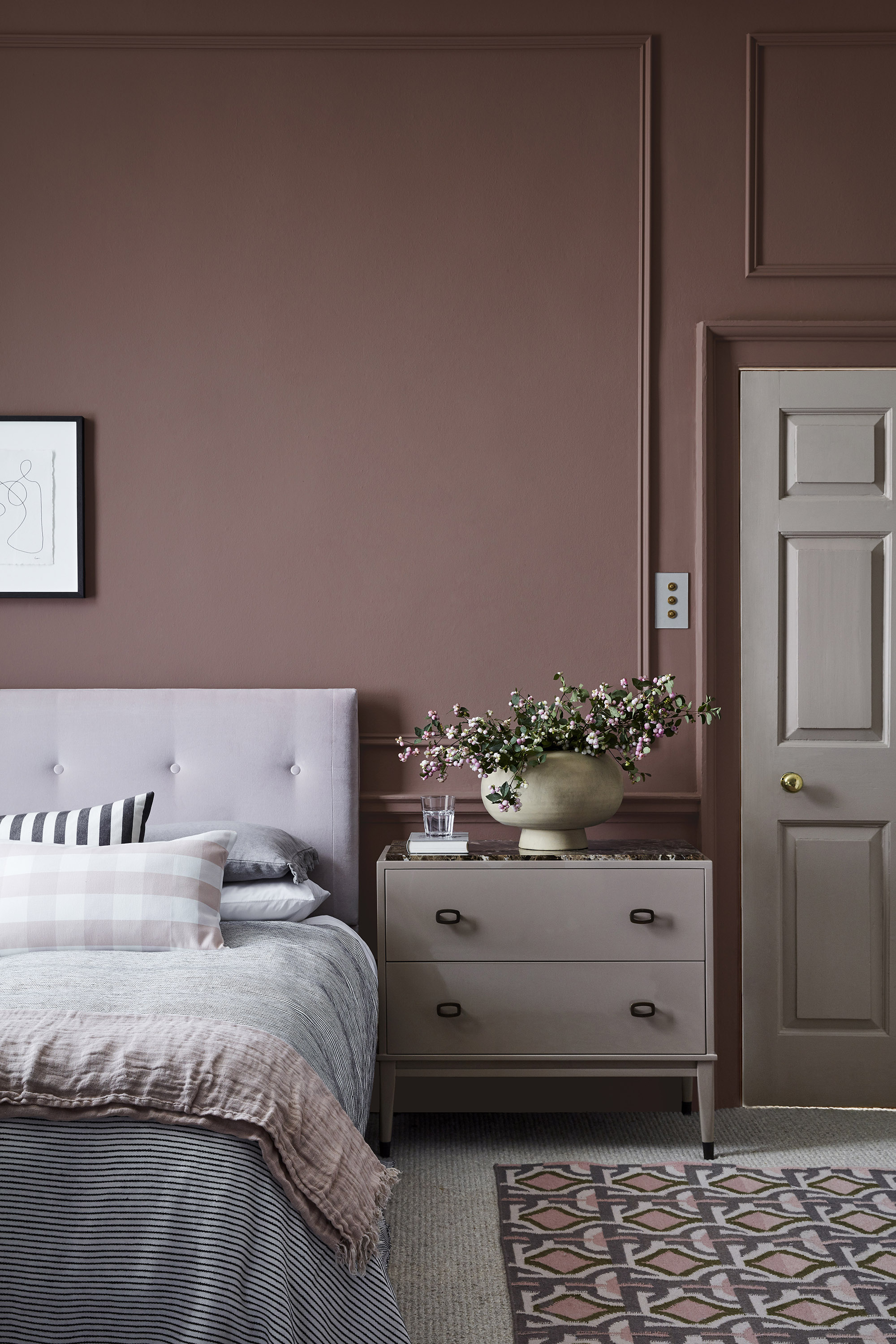
As spaces of relaxation, it's important for bedrooms to feel cozy and welcoming, so consider choosing warm, earthy tones inspired by natural pigments.
What colors make a bedroom feel warmer? 'Comforting natural tones are perfect for bringing warmth to bedrooms and can be used in an all-over scheme to create a cocooning feel,' says Ruth Mottershead, creative director of Little Greene. 'A deeper warm red such as Nether Red will create impact with a sophisticated and nurturing feel.'
This earthy pinky red with a warm yet elegant feel which would work well in traditional bedrooms.
Design expertise in your inbox – from inspiring decorating ideas and beautiful celebrity homes to practical gardening advice and shopping round-ups.
2. Select a soothing green
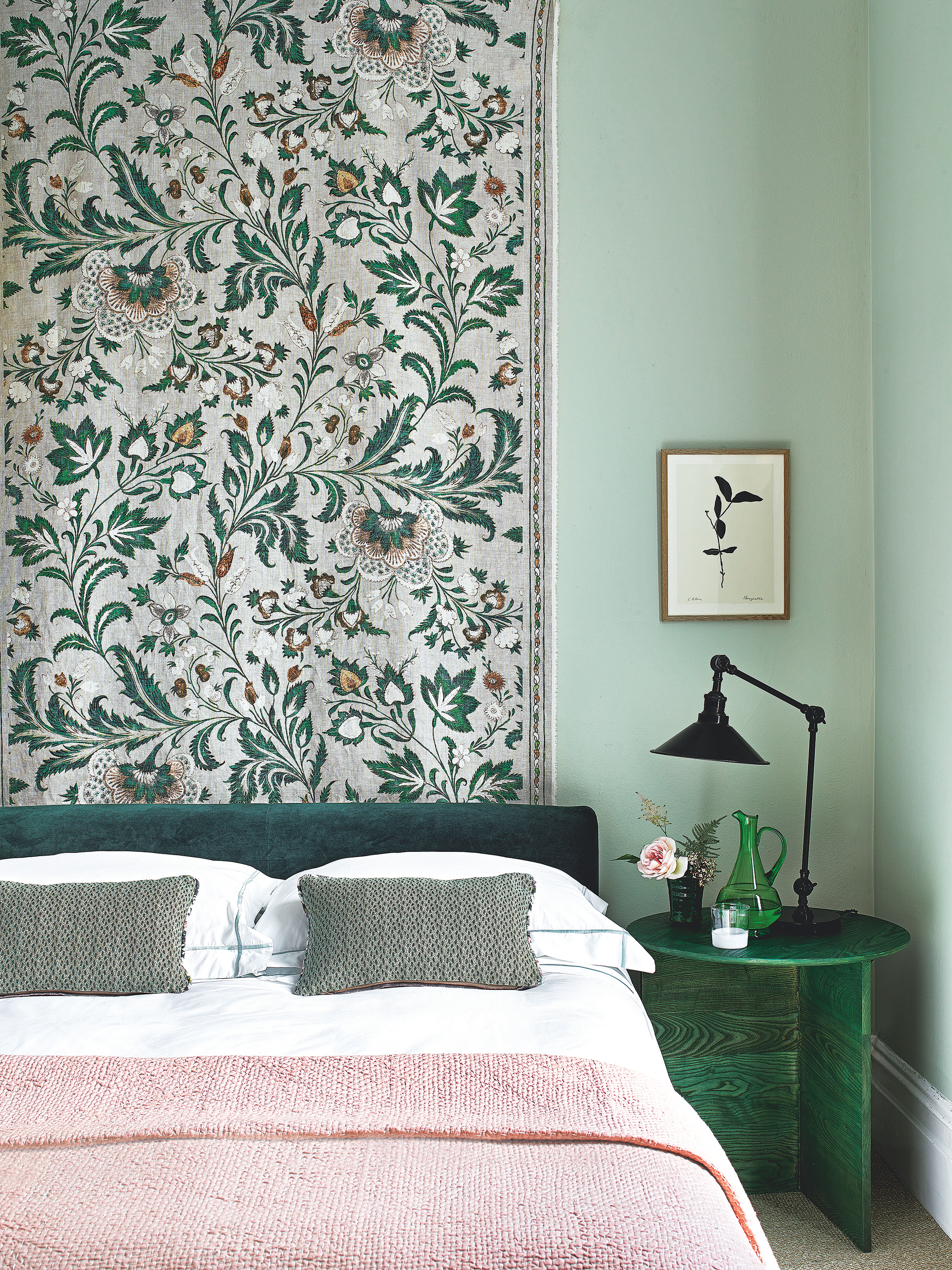
Inextricably linked with the natural world, green is a brilliant choice for bedrooms as it helps bring the nurturing powers of nature into the home and creates a soothing, relaxed feel, which is particularly important in spaces where we recuperate. It is also one of the most relaxing colors, according to experts.
'The bedroom needs to be a space in which to escape the day's stresses and carve that time out for us to focus on our health, wellbeing and getting the best night's sleep possible,' says Emma Deterding, founder and creative director, Kelling Designs.
Delicate pastel shades are guaranteed to create a restful feel. To bring life to green bedroom ideas consider adding accessories in a soft pink accent color or creating a feature headboard in a decorative fabric.
3. Embrace restful lilac tones

Currently witnessing a revival within interior design, soft and elegant purples such as lilac and lavender make wonderful shades for relaxing bedroom ideas.
’Once known as the color of the nineties, lilac is having a bit of a comeback as a natural go-to partner for the ever popular shades of grey, says Sarah Vanrenen of Vanrenen GW Designs. 'The paler shades of lilac and mauve are surprisingly versatile and when applied correctly, can be undeniably pretty.'
If you love lilac, consider using it on all four walls as part of a purple bedroom idea, alternatively it can make a beautiful accent color. 'Having all the walls in a room painted lavender can be a bit too much so an accent wall is preferred,’ suggests David Harris design director at Andrew Martin. ‘To add a modern touch to this relaxing shade, I’d pair it with soft gray hues for a cool and contemporary scheme.'
4. Introduce orange accents
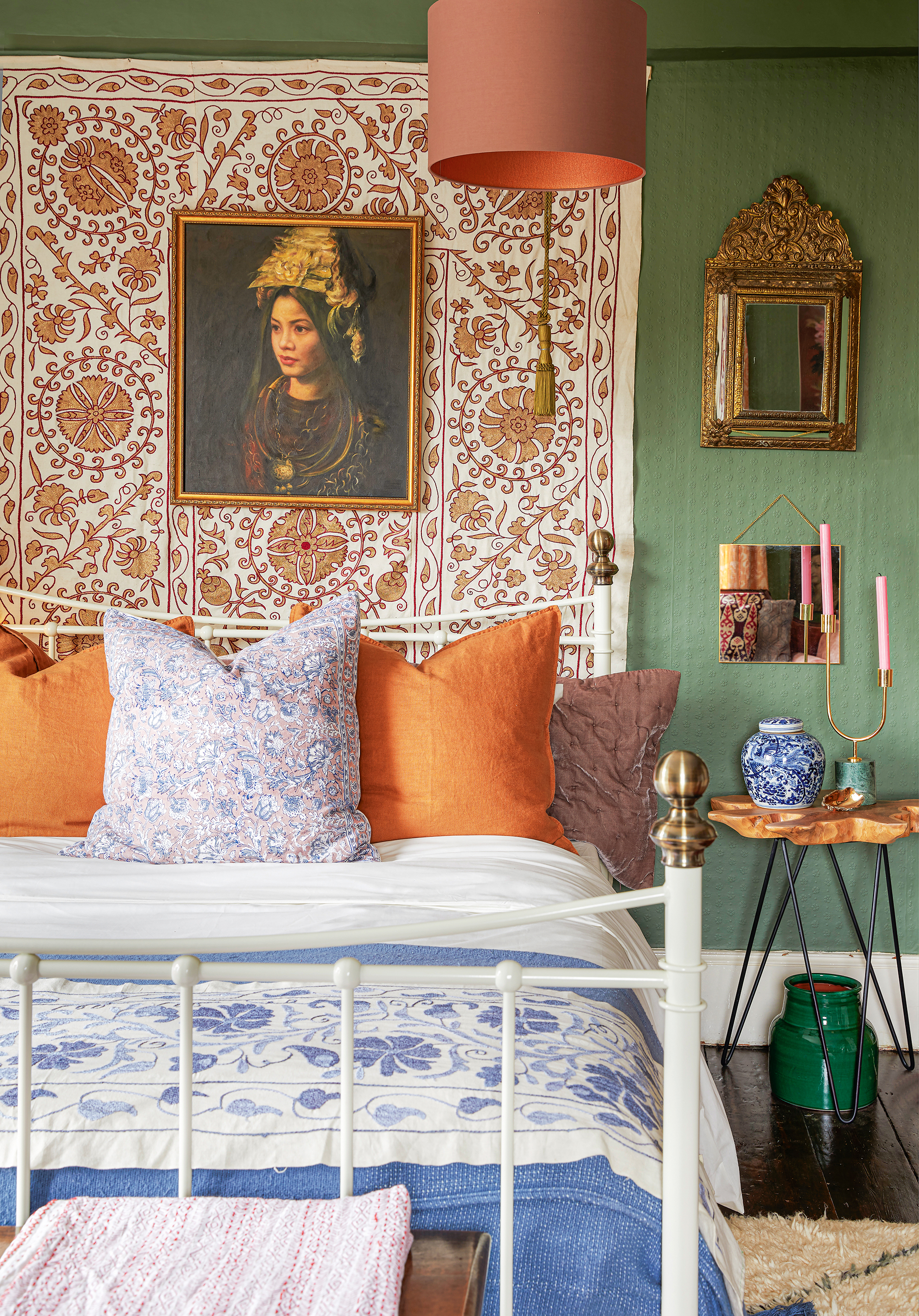
Warm and joyful, decorating with orange is guaranteed to appeal but it can be over-powering when used wall-to-wall in a bedroom. As an alternative, try introducing it as an accent color through cushions and lampshades.
Sitting opposite green on the color wheel orange makes a natural partner for green and look beautiful when paired as this green bedroom demonstrates. 'Introducing orange-toned soft furnishings and accessories to a textural space can bring it to life and make it feel immediately inviting,’ says Sam Hood, chief creative officer at Amara.
5. Start from a fabric
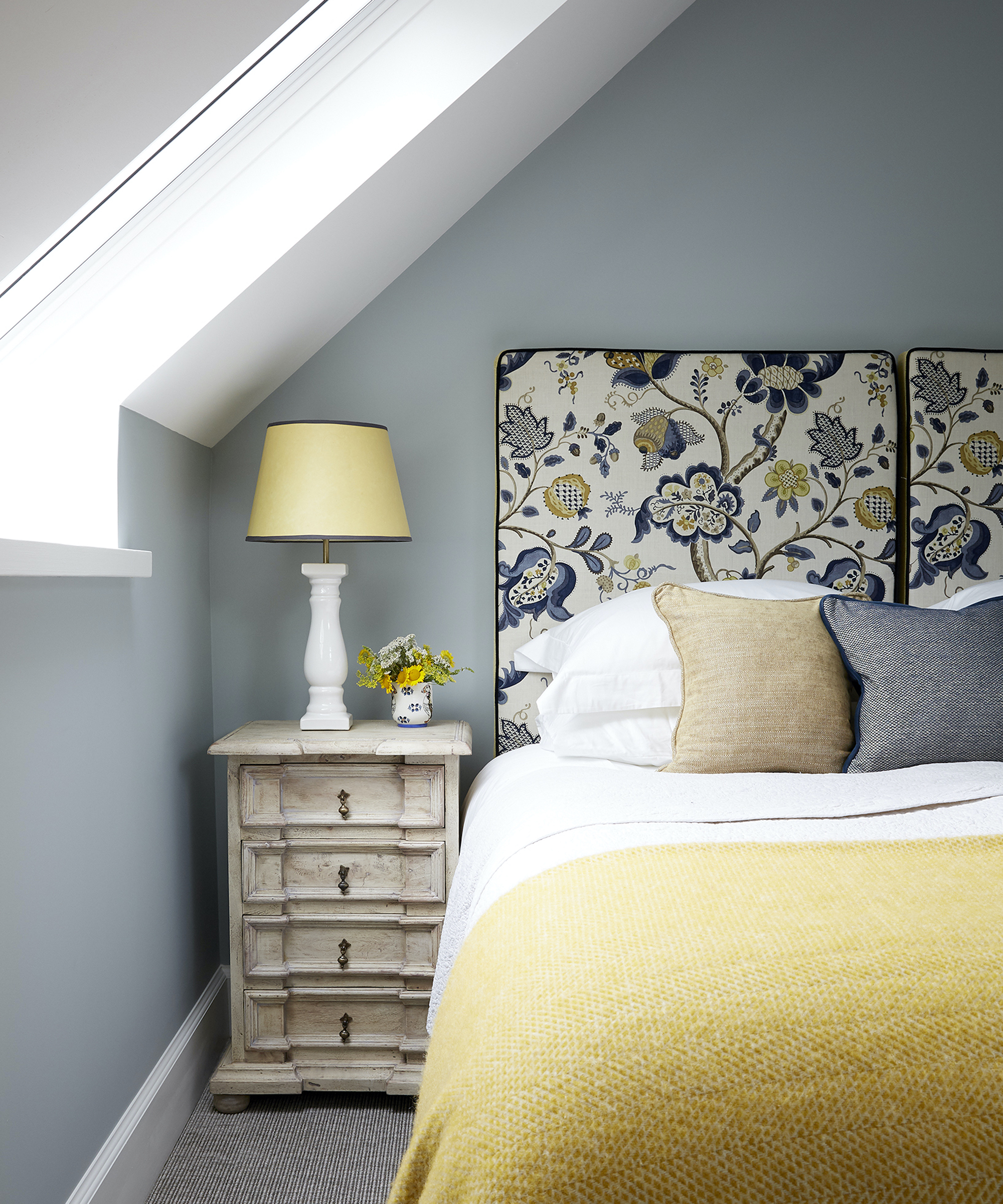
If you're unsure where to begin with bedroom color ideas then choosing a beautiful multicolored fabric for an upholstered headboard can be a good place to start as it gives plenty of shades to use as the basis for a scheme.
'Opt for an upholstered headboard as it will allow you to introduce color and pattern to the space, whilst acting as an anchor on which to base your design scheme,' suggests Emma Deterding, founder and creative director, Kelling Designs. 'Highlight key colors from the headboard fabric and use cushions and accessories in these shades throughout the room to create a cohesive look.'
In this small bedroom soft, uplifting tones of pale blue and lemon have been picked out from the headboard fabric to keep the space feeling light and airy.
6. Choose dark colors for a cocooning feel
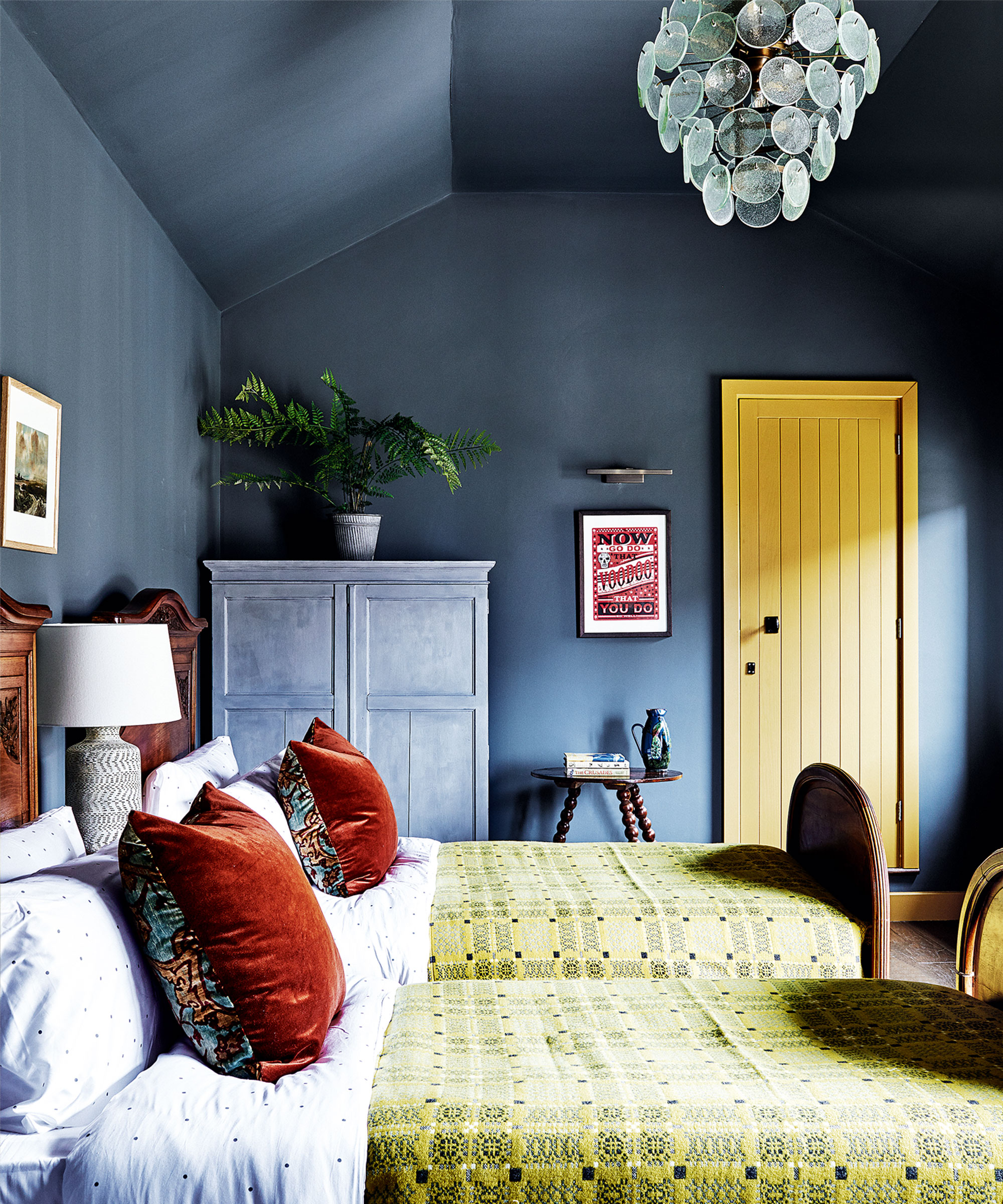
Bedrooms are private spaces where we relax and unwind so it's important we enjoy being in them. When choosing bedroom color ideas think carefully about the mood you want evoke, suggests Sam Hood, chief creative officer at Amara.
‘Choose a color scheme that’s going to make you feel calm and unapologetically you. If you’d like to feel cozy and safe, a darker color palette might suit you whereas if you’d like to feel awake and refreshed, a lighter color scheme mixed with brighter tones may be the perfection option.'
To prevent dark bedrooms feeling drab and lifeless consider brightening them up with a vibrant accent color such as zesty yellow.
7. Keep your bedroom color scheme soft and gentle
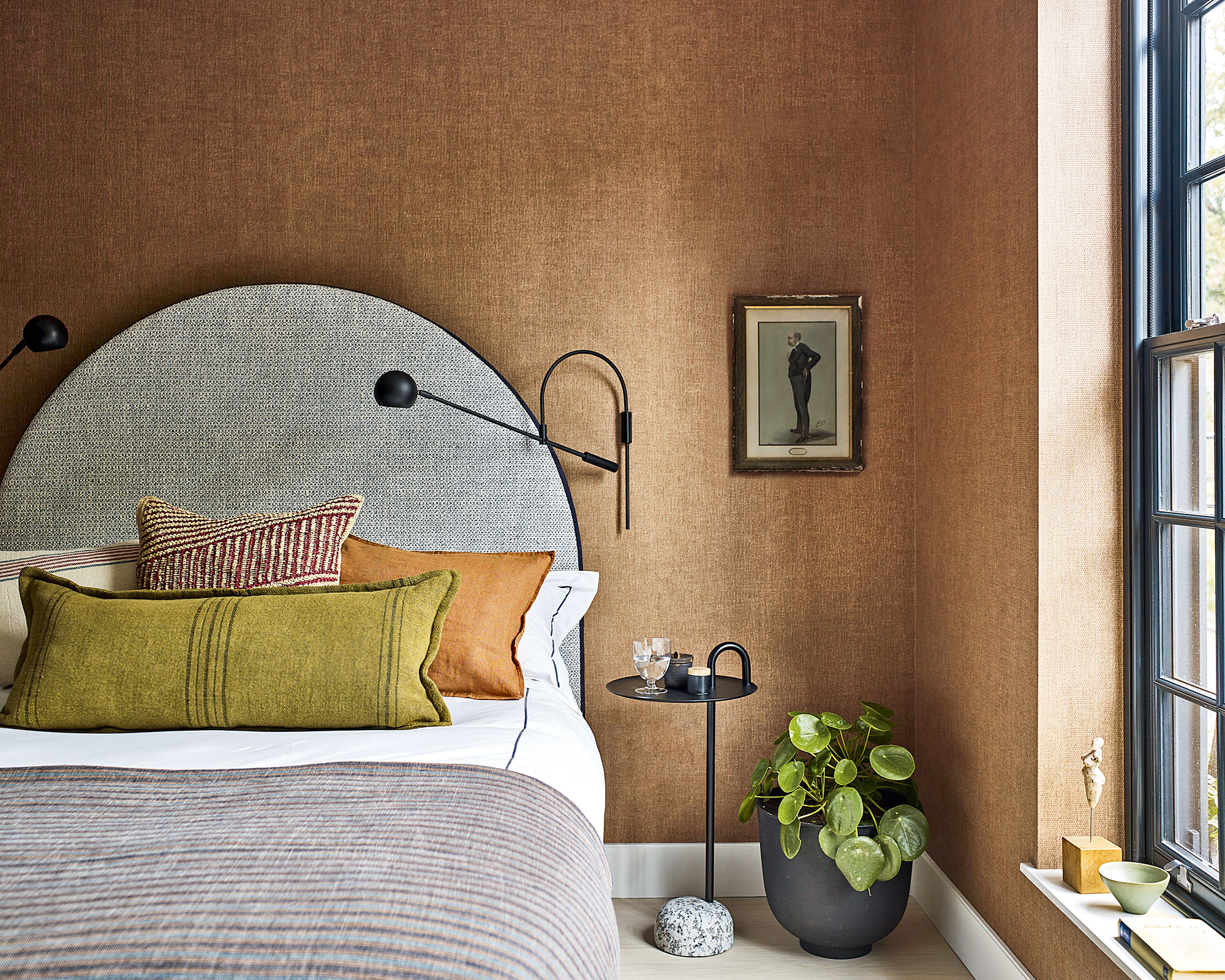
This is a contemporary bedroom but the use of soft tones, shapes and details creates connection with nature that makes it appear almost timeless.
‘For this Chelsea house project we worked to a selection of nature-inspired finishes,’ says Irene Gunter of design practice Gunter & Co, ‘with a strong preference for earthy terracotta and green and blue tones which are offset against sleek black details.’
Irene describes this bedroom as having ‘a lovely, cozy shape’ which was further enhanced by the ‘warm, enveloping’ hand-woven texture of the wallcovering – Casablanca from Altfield. ‘Having a curved headboard also allowed us to have a more generous bed size without it overwhelming the wall behind.’
8. Start with a moodboard

A moodboard can be the best starting point for bedroom color ideas. ‘Choosing the right colors for a bedroom design scheme is important when deciding how you want your personal space to make you feel – this may reflect a love of bright colors and opulent tones, or be more neutral and natural,’ explains Adam Black, co-founder of Button & Sprung.
‘To help determine the most suitable color palette for your bedroom, we recommend creating a moodboard and ordering swatches and fabric samples; this will allow you to experiment with color and texture to see what works for you.’
If you are undecided, make more than one moodboard and monitor what works and what doesn’t in different lights – and how each color scheme makes you feel. Learn how to make a moodboard to ensure that you've covered all the key elements of your space.
9. Combine soft hues with bold brights
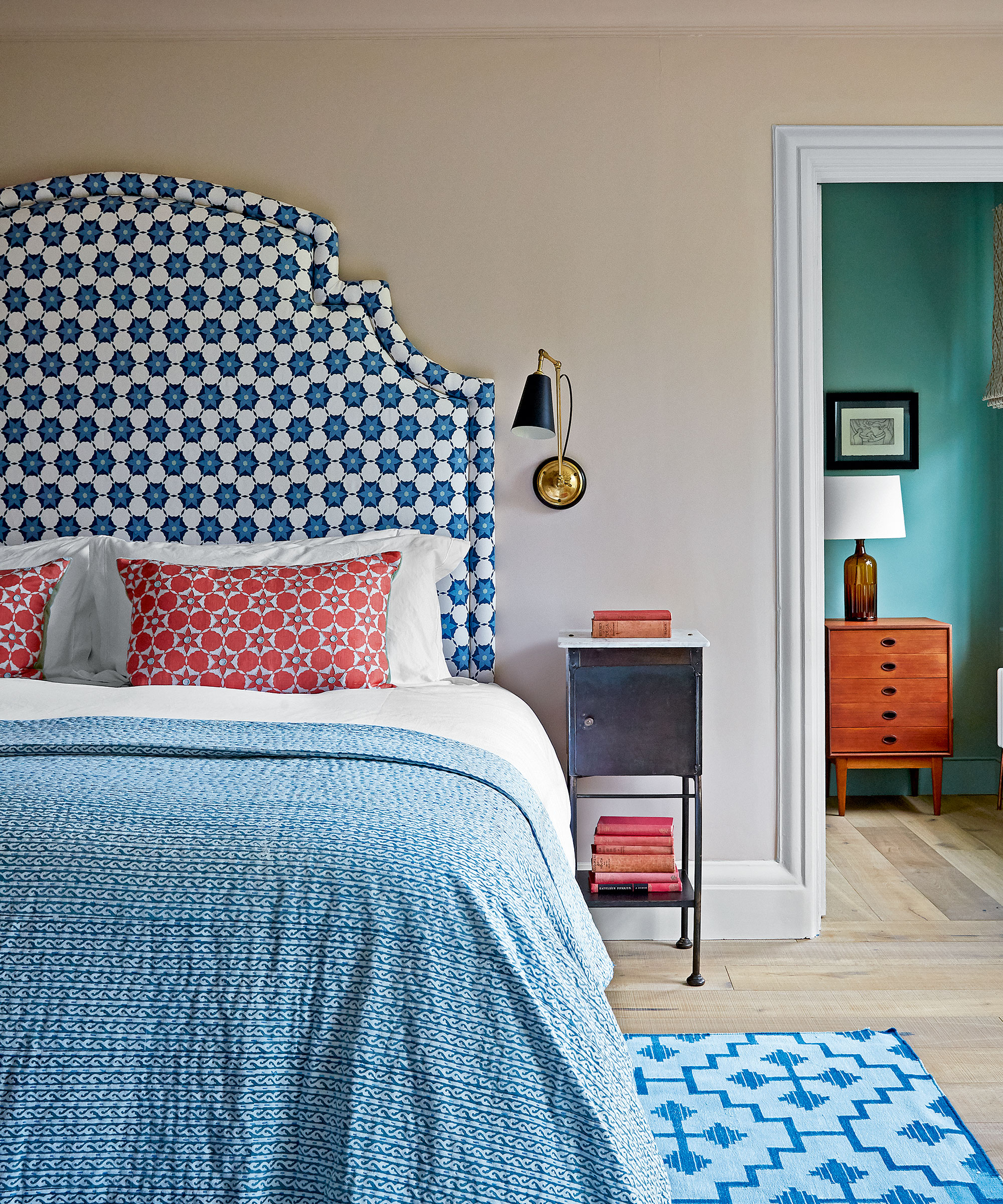
In this bedroom by interior designer Nicola Harding, the jewel green of the client’s husband’s dressing room contrasts perfectly with the soft pink walls of the bedroom (Farrow & Ball’s Setting Plaster).
‘We created an overall color palette that flows through the house and therefore has a sense of harmony,’ says Nicola. ‘We used paler colors in the rooms that have good light and stronger colors in the darker rooms.’
Arguably, the standout feature of this room is the vibrant headboard. Pattern on headboard ideas not only injects energy but, as Nicola points out, is also more forgiving than a plain one, should it mark. She had this headboard made by Naturalmat using the Carolina linen from Vanderhurd.
10. Consider the orientation of your bedroom
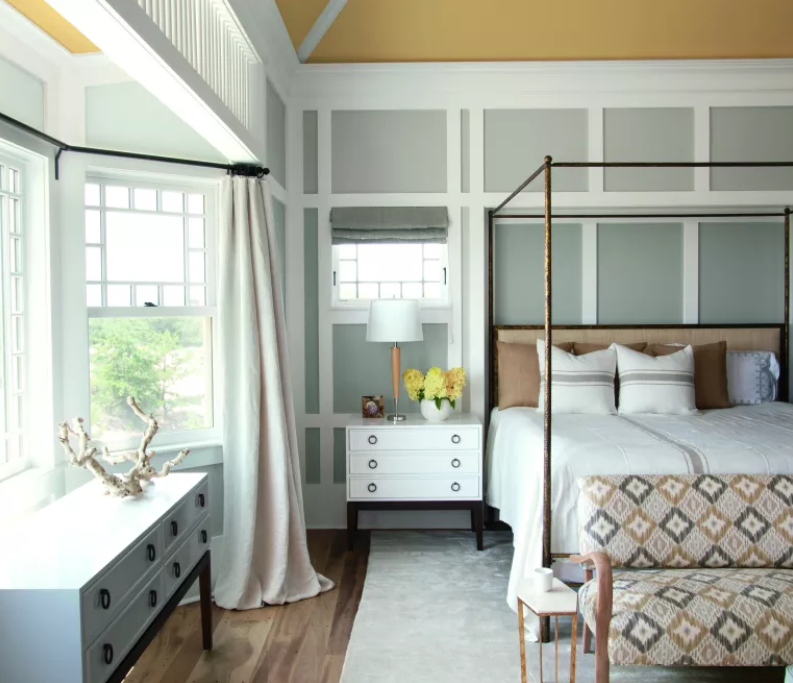
The orientation of your room is important when you choose bedroom color ideas. This is because the quality and temperature of light varies depending on whether your bedroom is north-, south-, east- or west-facing.
For example, a north-facing bedroom will have cooler light and therefore needs warming up with pinks, yellows and orange shades – or hints of them, like in this room above by Benjamin Moore.
A south-facing bedroom will have more of a glow and as such can take cooler blue or gray bedroom ideas. East-facing rooms get the sun early on and they work well with greens and blues; west-facing rooms get the sun in the afternoon so suit colors similar to east-facing spaces – their orientation is more balanced essentially.
If you prefer neutrals, then choose tones that will cool down or warm up the space, depending on its orientation – a warm pale pink for cool rooms, for example, or a barely there gray for sunny spaces.
11. Modernize your neutrals with gray

If you’re looking for a neutral bedroom scheme that feels fresh and modern, embrace gray bedroom ideas.
‘Grays are hugely versatile, from cool off white shades, through warmer neutral mid tones to the very deep and mysterious,’ says Judy Smith, color consultant at Crown. The walls of this bedroom put together by Jonathan Adler lean towards the darker end, but are kept fresh by being paired with crisp white.
‘They have more color and texture within them than straight black,’ adds Smith. ‘A monochrome scheme of black and white is much more unforgiving than shades of slate and clay, which will change subtly with the light throughout the day, giving them personality and character.’
12. Are you a morning or evening person?
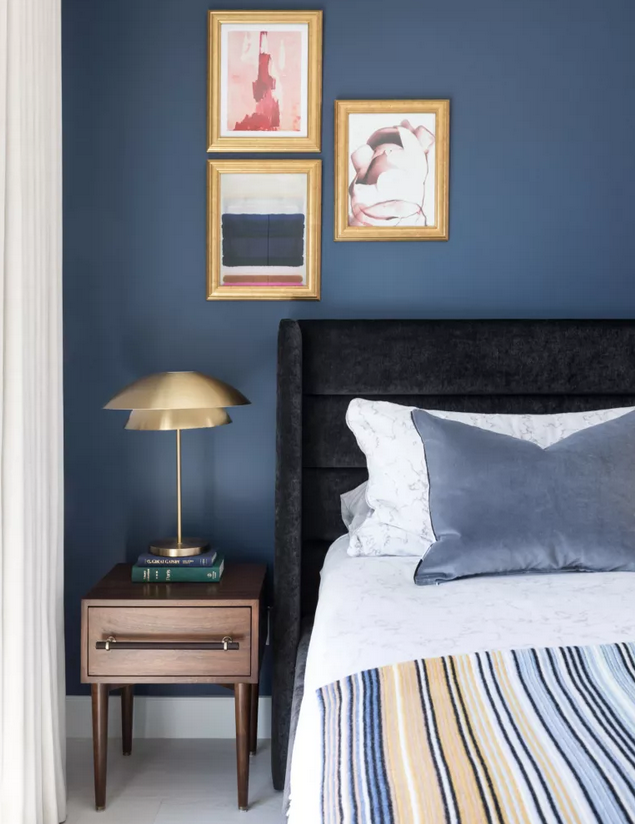
‘Bedrooms are deeply personal spaces and should be decorated accordingly,’ explains Joa Studholme, color curator for Farrow & Ball.
‘If you are a morning person who likes to jump out of bed and attack the day first thing, then you are probably more suited to having a clean, light energizing color on the walls. Evening people will more likely embrace the dark, womb-like shades or a sumptuous wallpaper.’
Smokey blues – as in this sophisticated blue bedroom by Gillian Segal Design – will suit evening people. You can add a spot of luxury with some velvet accessories and gold elements. Mahogany pieces create depth, too.
13. Go from morning ‘til night with white
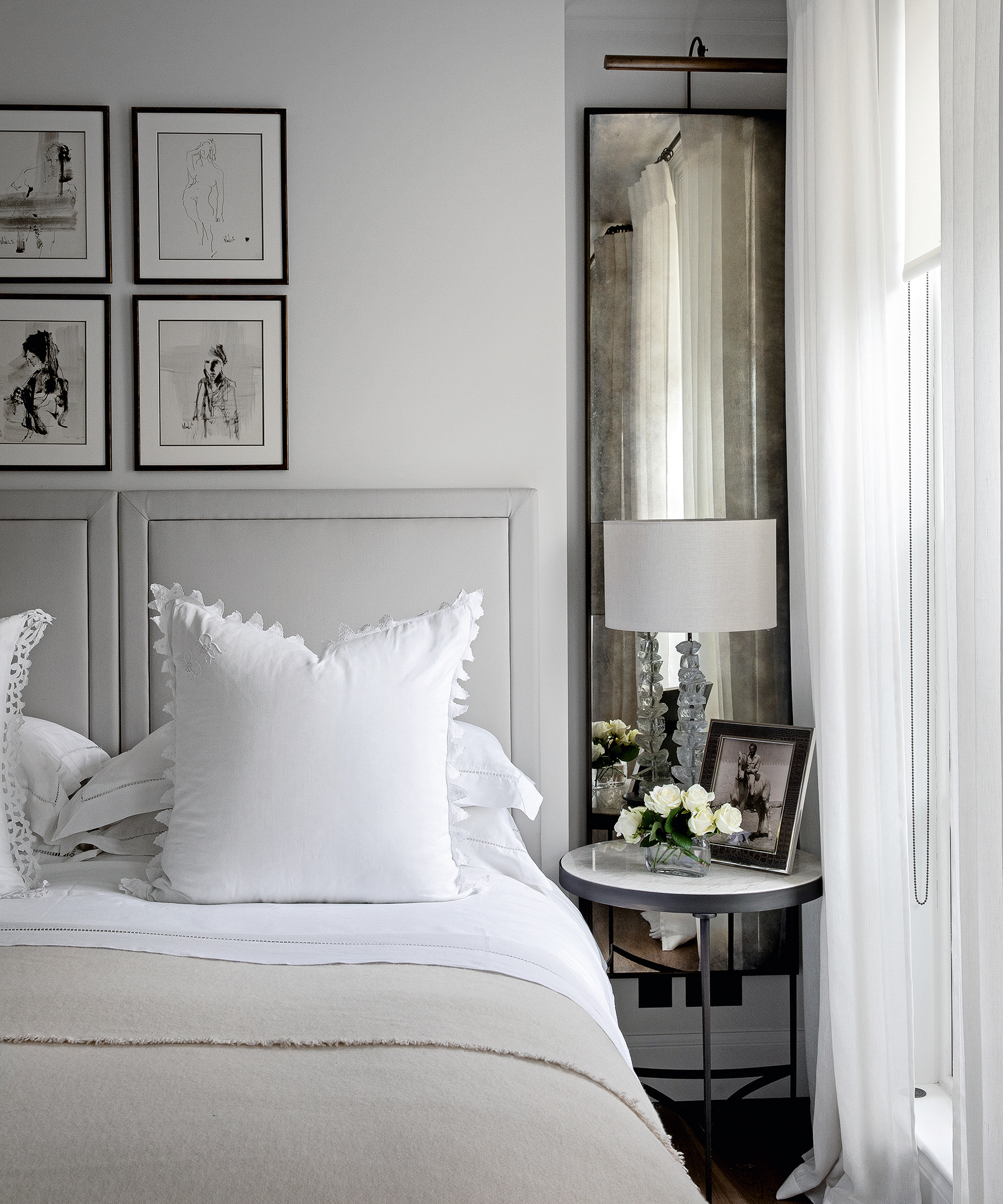
Heading towards the lighter end of the spectrum, white bedroom ideas have the unique ability to feel both soothing and calm before sleep, but bright and airy in the mornings. Layer whites on whites to create a sophisticated, elegant scheme and embrace both gentle tonalities of white – from dove grey to ivory – as well as layers of texture. On the bed, use classic crisp white sheets as the base, and make the room feel cozy with woolen blankets and boucle cushions.
14. Look to your headboard for color inspiration
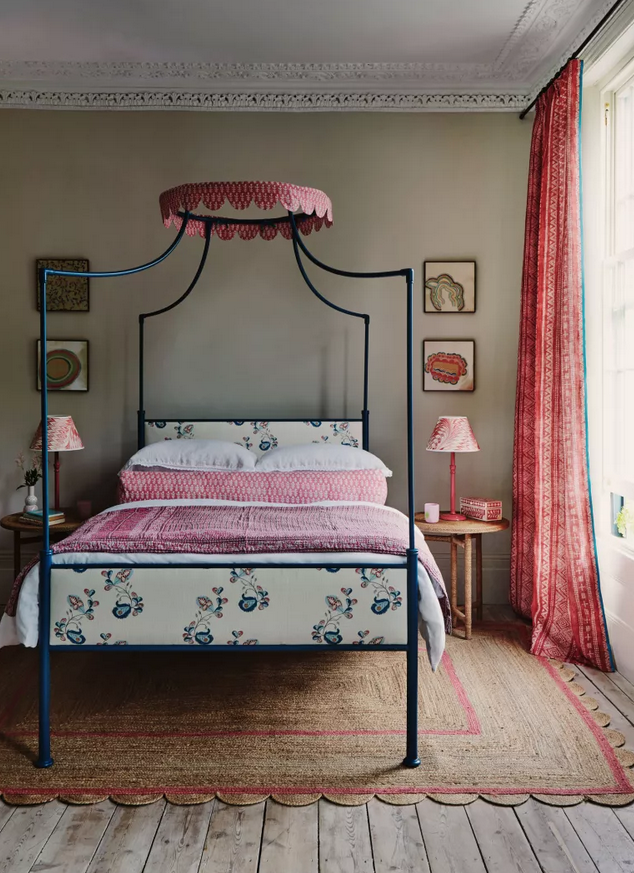
Bed and headboard ideas are the focal point of a bedroom, and are often the starting point around which to center bedroom color ideas.
Choosing a bedroom color that takes an accent shade from your headboard's fabric – or indeed acts as a contrast – will add depth and detail to the scheme.
Mariana Ugarte, co-founder of London based design studio Interior Fox, explains: ‘An upholstered headboard is an easy way of injecting color and texture into your bedroom, especially when designing within a smaller space.
'For a luxurious look, introduce plush velvets in rich earthy tones; these work well against a neutral backdrop while keeping the space light and airy. Add contemporary piping in a contrasting color to the edge of your headboard; this instantly adds a twist to any standard headboard and broadens the color scheme.’ To choose the right shades, use a color wheel.
15. Rouse yourself with earthy reds
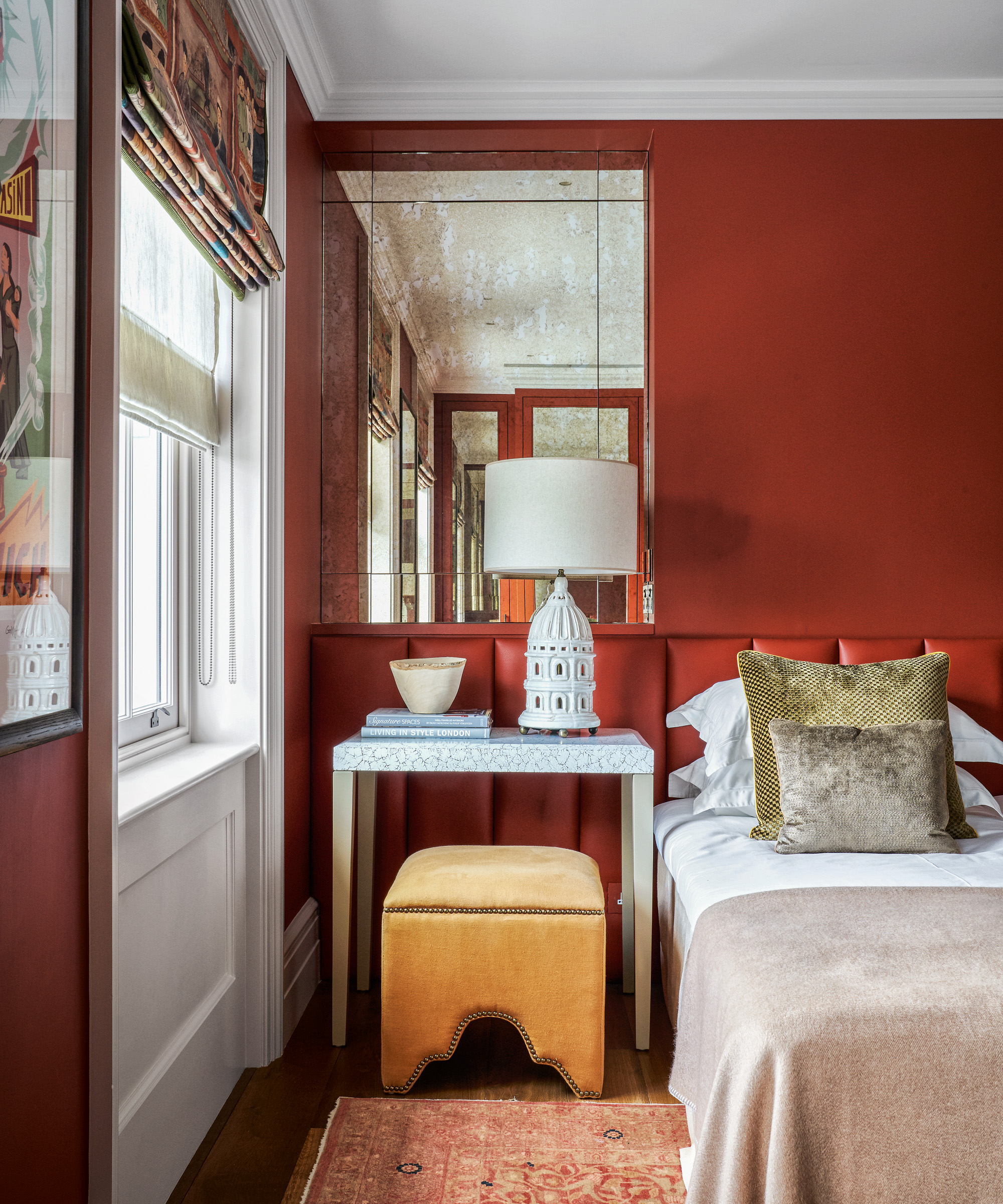
Your bedroom scheme needs to not only help you fall asleep, but be a pleasant environment in which to wake up. ‘As a guide, warm colors such as red, orange and yellow are considered to be stimulating while cool colors such as blue and green tend to be more restful,’ says Smith. ‘It’s useful to consider these factors when designing spaces, we live, work and play in.’
If you’re the type who likes (or needs) a bit of get-up-and-go in the mornings, consider earthy tones of red. While not traditionally thought of as a bedroom color, these reds are at once regal and romantic. To keep this choice feeling modern, choose a red with an orange undertone, pair with crisp white ceilings, and accessorize with ochre pieces like in this North African-inspired scheme.
16. Choose primary, secondary and tertiary colors
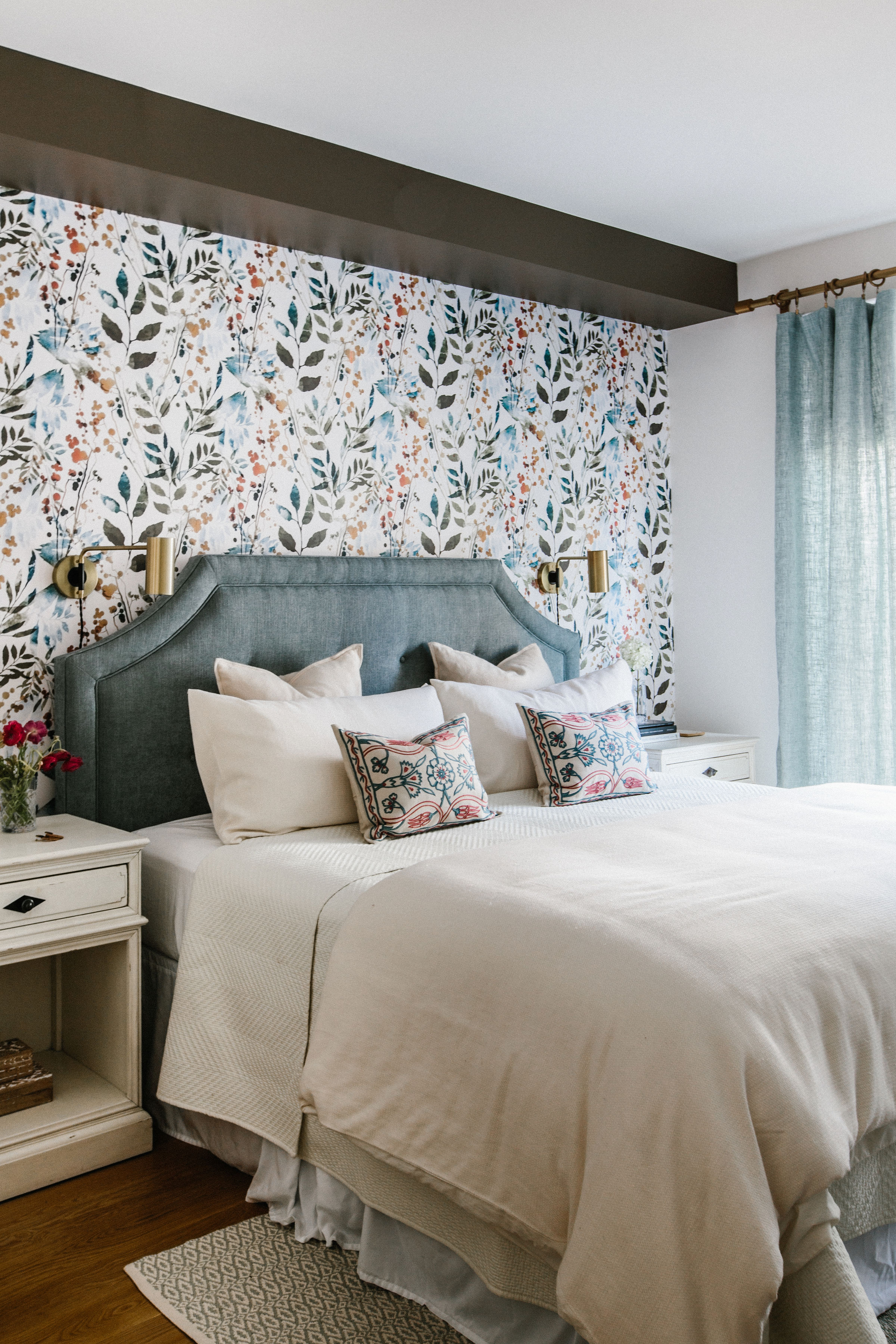
Picking the primary color for a bedroom may not be inspired by a large feature, such as a bed – so if you are originating your bedroom color scheme from scratch, ensure you choose second and tertiary accent shades before you start to decorate.
‘It's great to pick a color that you want to be the primary color in the room and then make sure it's in a prominent place, whether it's the headboard, wallpaper, rug or drapery,’ says Corine Maggio, founder of California-based CM Natural Designs.
‘Then you'll want to repeat that color somewhere else in the bedroom but in a smaller way, and blend in a secondary or tertiary color through your choice of pillows, art, accessories or, again, rugs or bedroom wallpaper ideas.
'The key is finding the right balance between the bedroom colors you're using, and don't be afraid to try something new. Find the big pieces you know will work and then take some chances with the smaller items. You can always replace those if need be.’
17. Choose blue for a serene scheme

‘I love blue in bedrooms because it’s contemplative and calming,’ says artist and color expert Annie Sloan. ‘My bedroom is painted in deep dark Aubusson Blue because I wanted the space to feel cosy and calm.’
An enduring favorite, blue bedroom ideas are proven to have a soothing effect on the brain, helping ready you for sleep. While lighter blues or bold accents are more instinctive choices, don’t be afraid to use darker shades on the walls. In this bedroom by interior designer Alexis Hughes, a deep navy blue paint is paired with white ceilings and a gloss finish to allow light to bounce around the room.
18. Combine bedroom paint colors with wallpaper

How fabulous is this bedroom by Paint & Paper Library? We often think of wallpaper being multicolored, but it works really well in a monochromatic scheme if you pick the right design, plus you can use it as a great swathe of color if you don’t want plain painted walls.
This all-encompassing green bedroom color scheme will suit those who want to relax in a soothing and calming environment. The wallpaper is cleverly designed to fade as it gets to the top, and perfectly matches the ceiling color.
19. Head over to the dark side
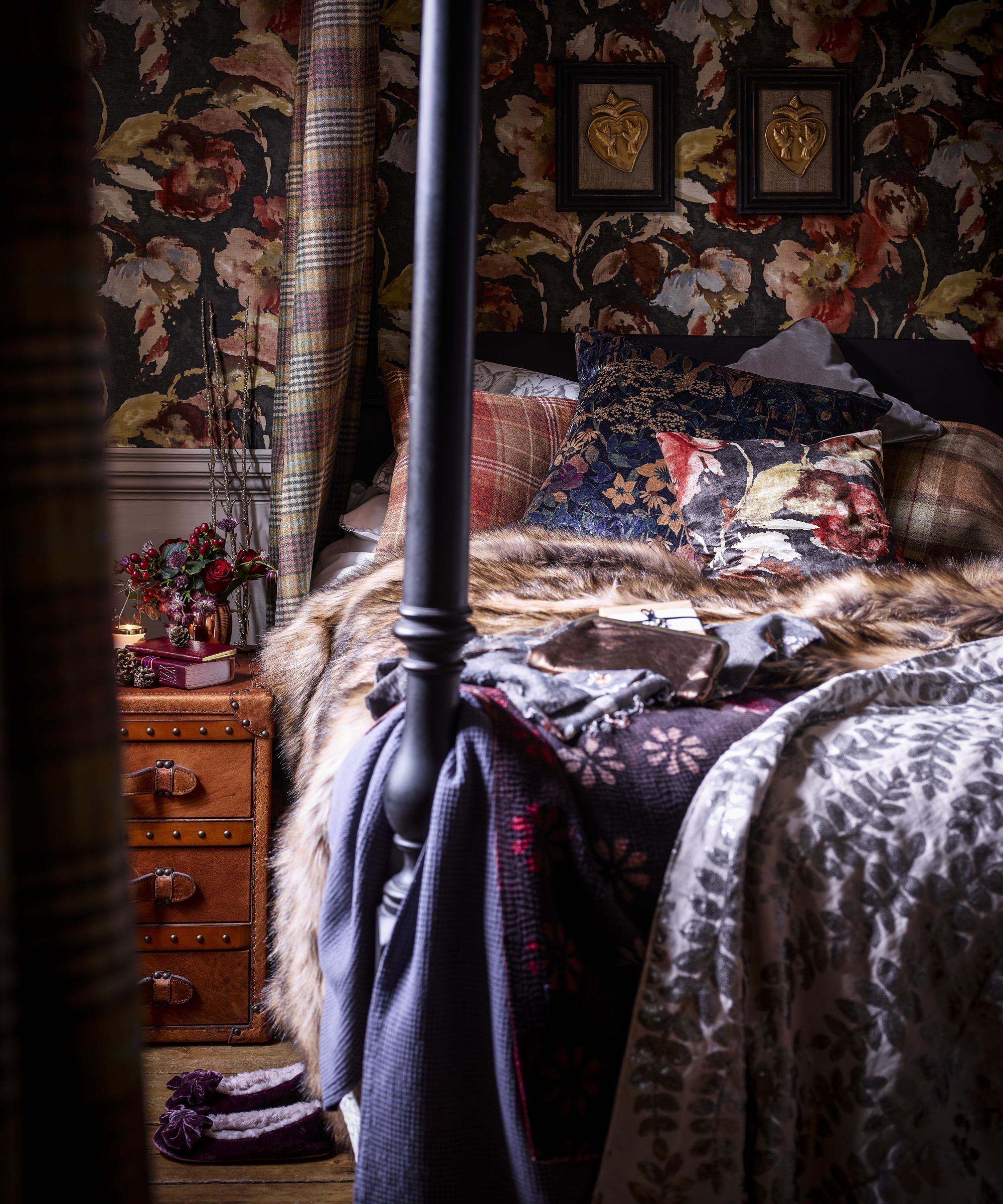
Far from being fodder for moody teenagers only, dark bedroom schemes are gaining in popularity among the design conscious, with even black bedroom ideas making waves among jewel tones of blue, burgundy and green.
‘Darker tones of charcoal can be used to add drama anywhere in the home, from a living room to a bedroom or even a small hallway,’ says Smith. ‘With clever lighting and mirrors you can create a look that is both strong and atmospheric.’ In this bedroom, a black-based wallpaper design is built upon with patterns-on-patterns in autumnal tones, a black four poster bed framing the look.
20. Choose patterns to complement bedroom colors
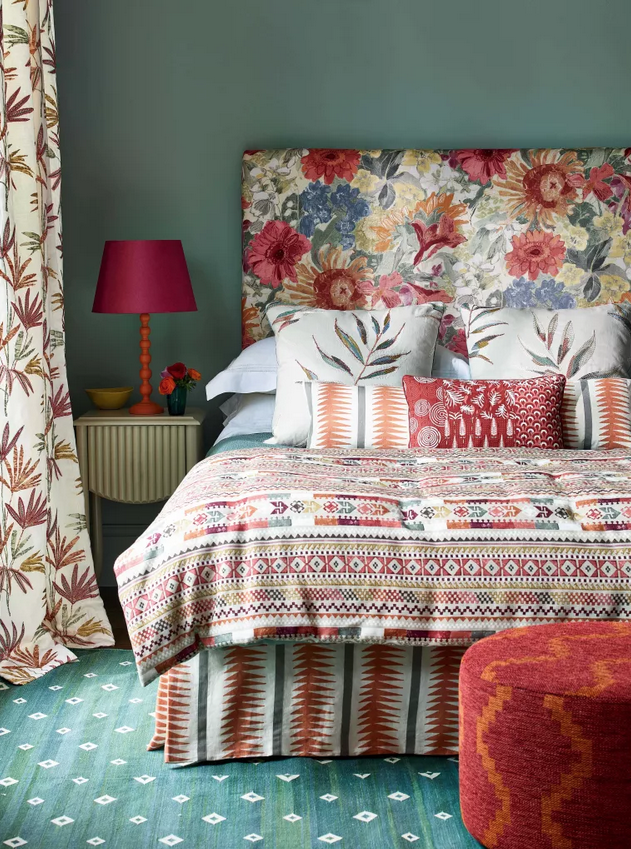
When you want to use a mixture of different scale patterns, the best way to start is with a single color – take the sage wall in this bedroom by Jane Churchill as an example.
Then, find a variety of patterns and prints you love that have this key color in them. It could be subtle – a leaf or a stripe – but it will be enough to tie it in with the main color that will then anchor the patterns. Then you can use them on the headboard, pillows, drapes and throws.
21. Let the natural world in with green
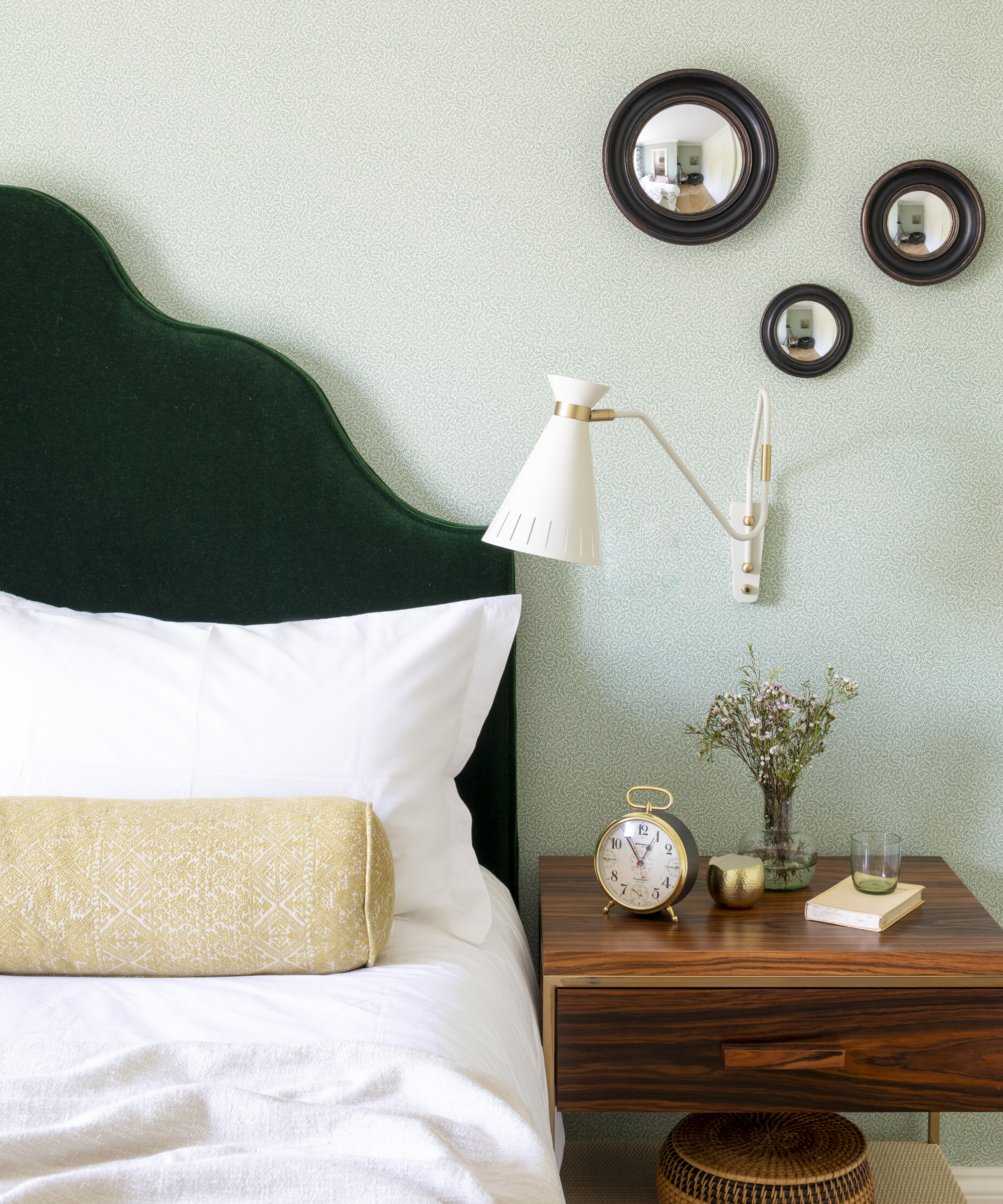
Following a huge paint trend across much of the home, green bedroom ideas are a great way to channel the invigorating and relaxing qualities of the natural world. ‘Green is a grounding, calming colour and works beautifully in bedrooms, especially when paired with the right lighting to make the most of all the pigments in a high-quality green,’ says Sloan.
In this room by design agency Kitesgrove, a small format white and green wallpaper is paired with a deep emerald velvet headboard. ‘Greens are soothing and a bit more unexpected than a blue if you are trying to introduce color,’ says interior designer Zoe Feldman. ‘Incorporating wallpaper can create a ‘jewel box’ that hugs you in your bedroom.’
‘Dark green paint colours are best used in a space with good natural lighting or somewhere you’re hoping to create a sense of cosiness and safety,’ adds Sloan.
22. Consider your color under all light levels
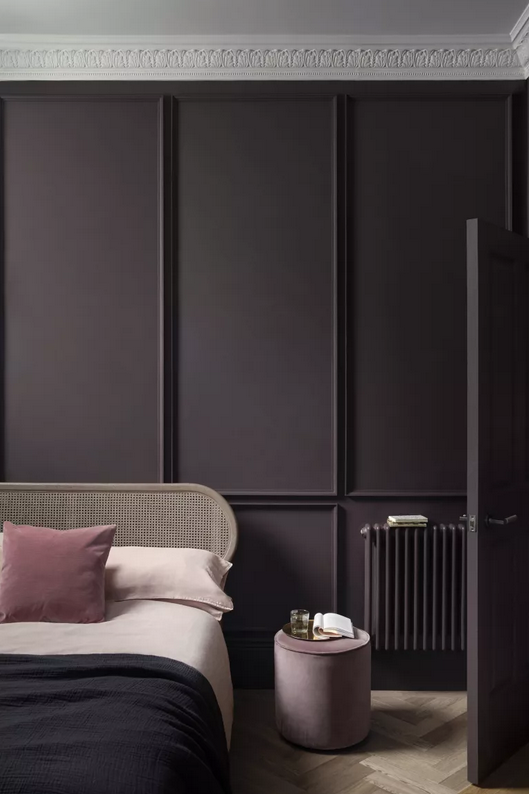
We talked about choosing the bedroom color ideas depending on your room's orientation, above. But don't forget to factor in your bedroom lighting ideas.
Choosing bedroom colors should be done by lamplight, too, as colors change dramatically under artificial light: white bedrooms will look creamy, pale neutrals will look deeper and darker, and dark schemes like the one above will look near-black.
To make dark bedrooms work, balance is your best friend – keep the dark tones on the wall and accessories, and use pops of pale shades for contrast. Keep the ceiling light so it’s not overpowering and use mid-toned wood flooring – parquet is great as it adds a subtle pattern to the scheme.
23. Warm up blue’s benefits with purple

‘Purples in general are warm, comforting colours,’ says Sloan. ‘They have the receding values of blue, making a space feel larger, as well as the warming properties of red, making a space feel cosy. This makes them great for bedrooms.’
When picking your purple, you’ll need to choose your shade carefully to avoid the scheme feeling dated. Pick a tone with some grey in it like in this example, stay light with pale periwinkles, or delve into the dark bedroom ideas trend with eggplants, mulberries and grapes.
24. Add bold accent colors to neutral schemes
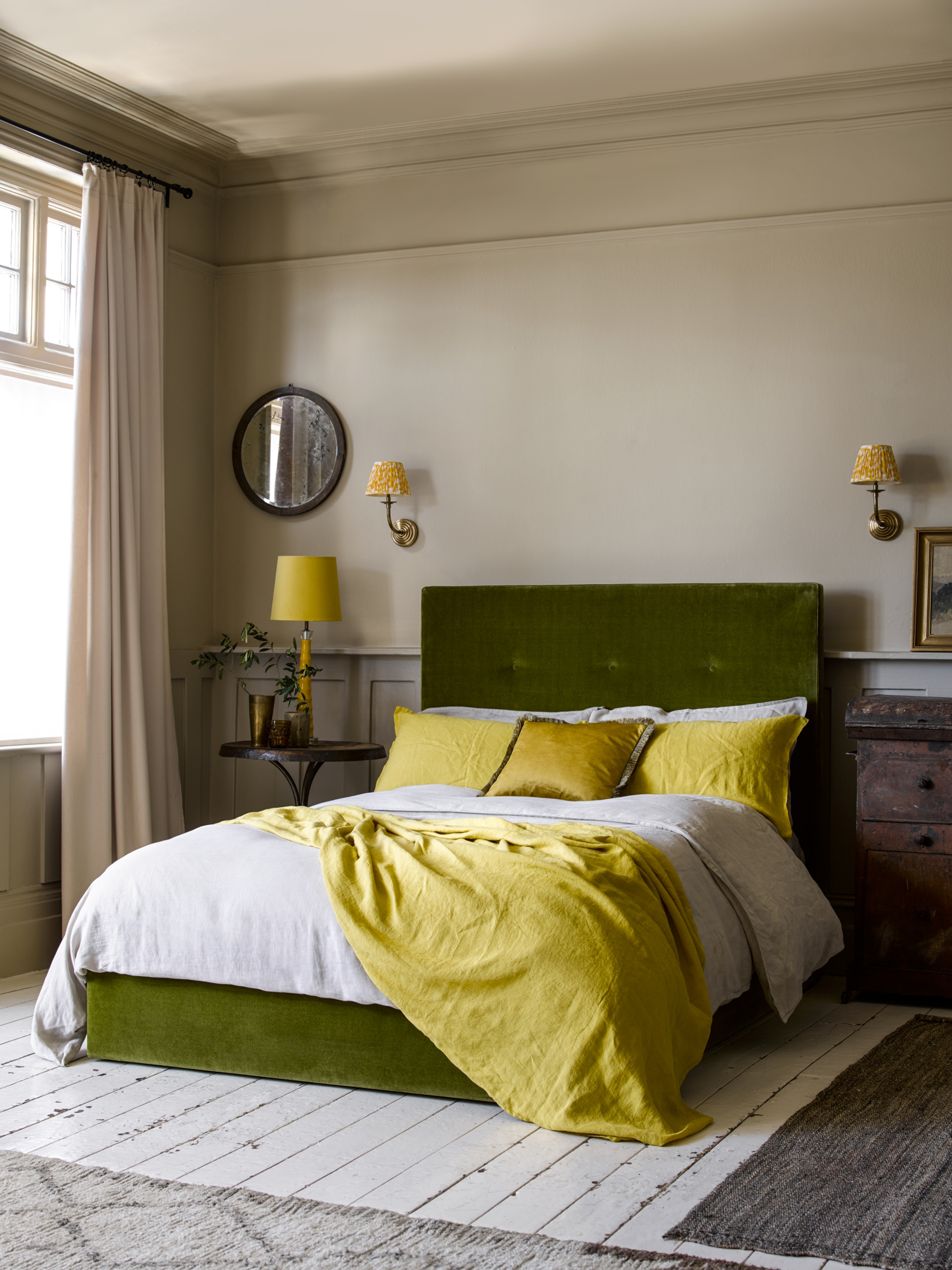
Accent colors are the perky color, the standout burst that complements and pushes the scheme to new heights. They are used for the accessories – throws, pillows, rugs, vases and, more commonly at the moment, lampshades.
Rohan Blacker, founder of Pooky explains: ‘Bedrooms are the perfect room in the house to experiment with shade colors, using brighter hues to add accent tones to your scheme or to match a throw or a pillow.
'We have seen an uplift in sales of our brighter, more vibrant shade varieties; customers are pairing them with more neutral pared-back interior schemes, or perhaps just finding the confidence to go for a more adventurous design.’
Are you a morning person? The bright bolds will work for you.
25. Layer harmonious colors
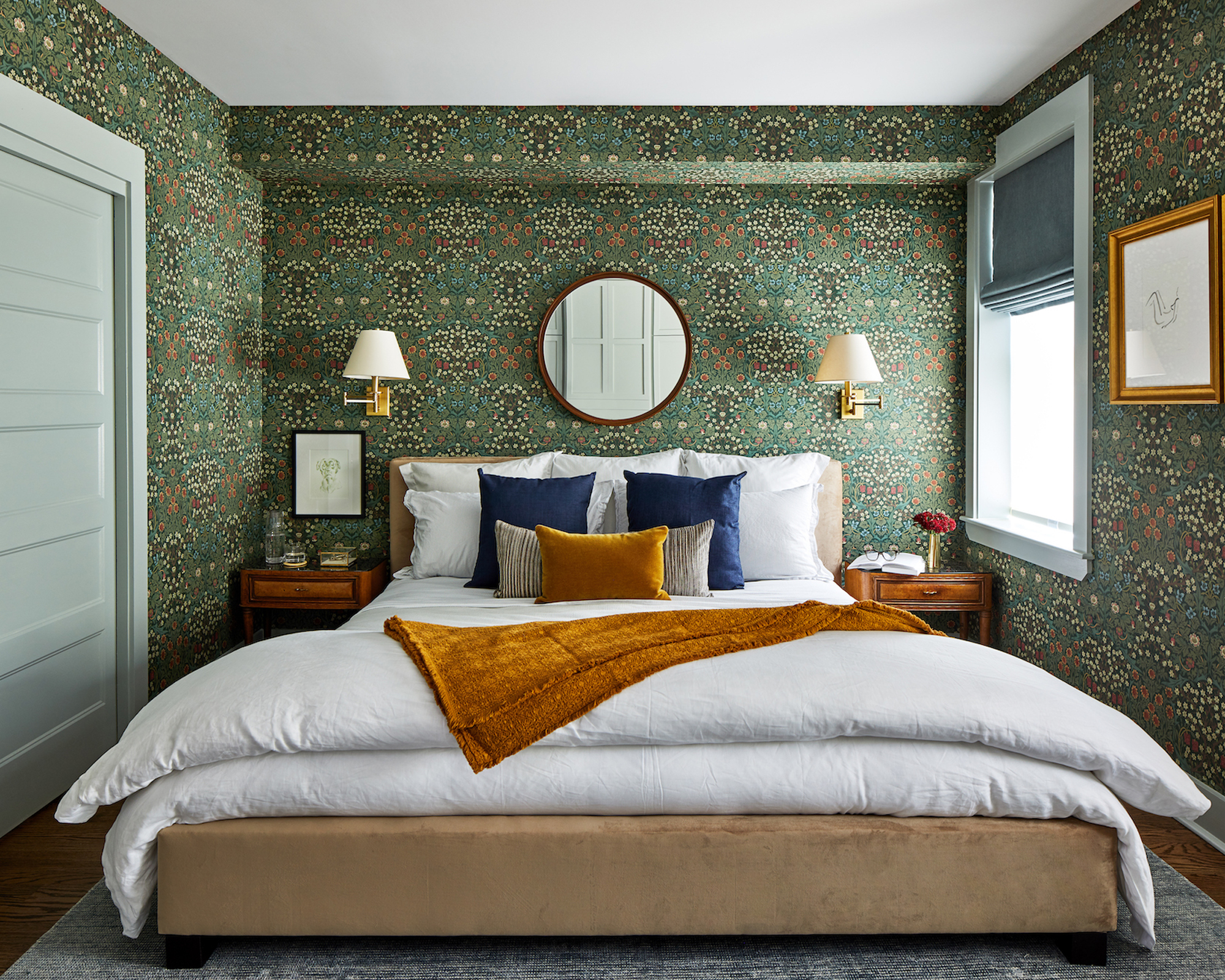
Of course, it’s often not just one color you’re looking to decorate with in a bedroom – especially if you’re delving into the world of bedroom wallpaper ideas like in this example by Feldman. To create a coherent scheme that feels unchallenging and enveloping at the end of the day, layer up on harmonious colors i.e. ones that sit beside each other on the color wheel. In Feldman’s design, a green-based wallpaper is paired with blue and yellow scatter cushions on the bed, mirroring the details in the pattern.
26. Pick matching tones to create a calming scheme
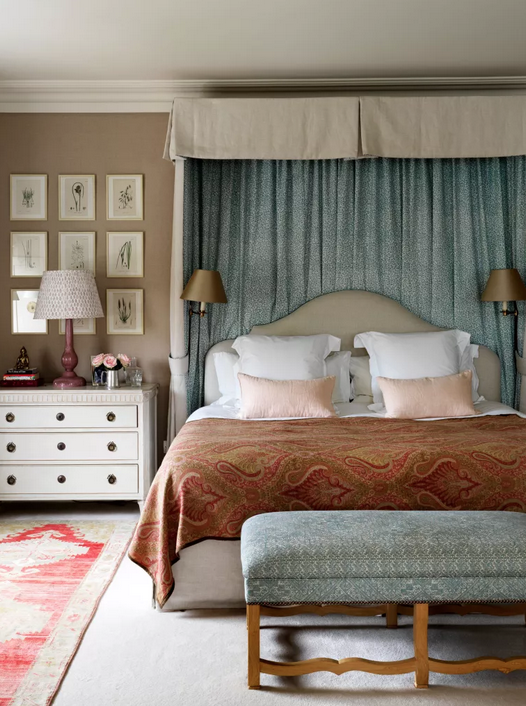
We’re not all fans of color and drama, and there’s something so beautiful about a well chosen neutral color scheme – especially if you want your bedroom to feel restful. And if the remainder of your house has the same feel, then matching your bedroom to your neutral living room ideas, for example, will add cohesion.
Mary Graham, co-founder of Salvesen Graham shares her advice: ‘We often start our bedroom schemes with a more muted palette in mind, particularly for master bedroom ideas, but still relate to the colors in the rest of the house.
'You want to create a room that is light and bright in the morning but cozy in the evenings. Think about how choices of fabric will affect how sounds and noise might come into the room. Fabric walling is a great choice, if budget allows, for acoustics.’
27. Rethink pink and choose a natural shade
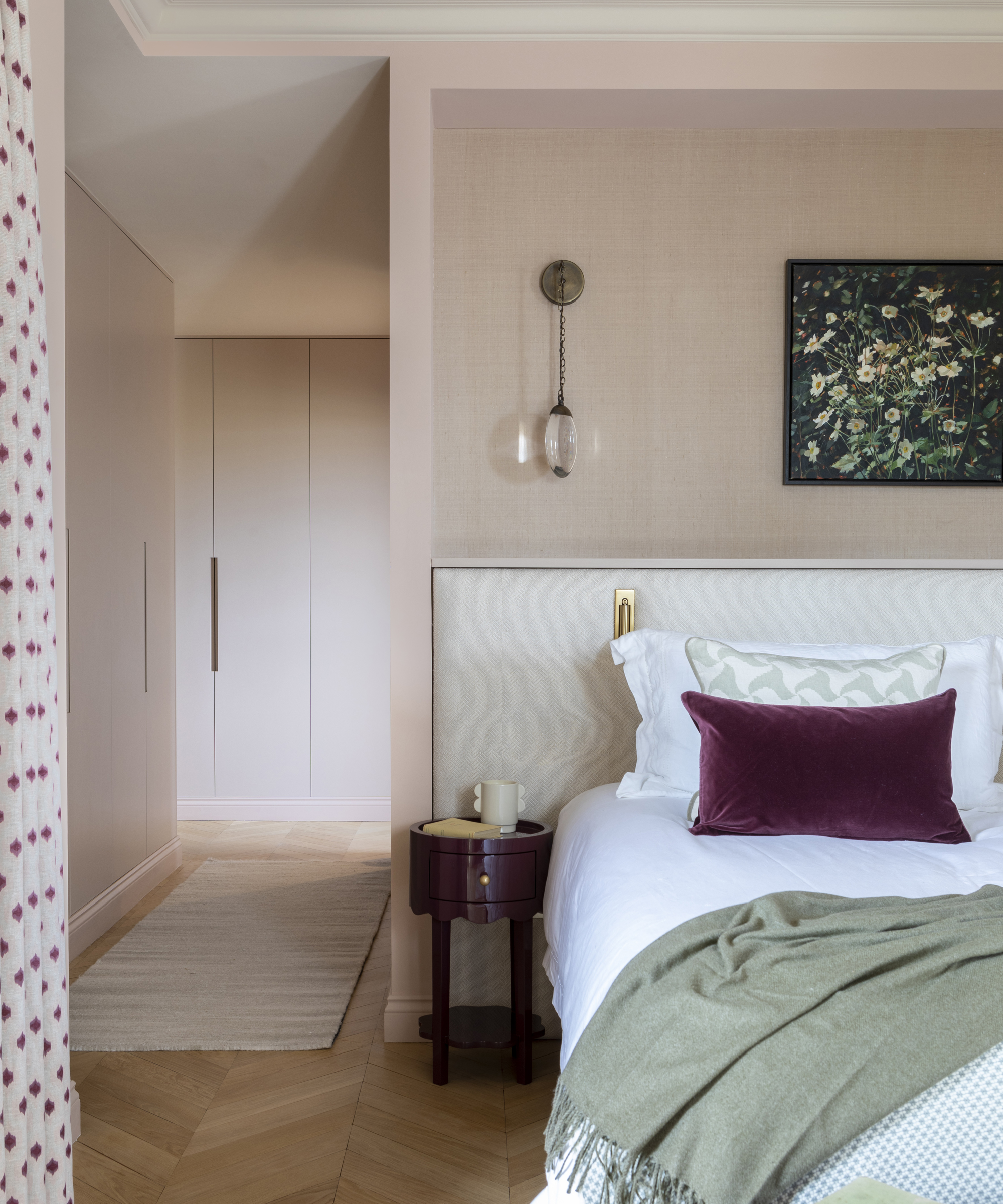
Long gone are the days when pink was just for bedroom ideas for girls. The color is gaining traction across all rooms of the house, and showing a new, earthier side to itself. Pink’s comforting qualities make it a perfect pick in a bedroom for all genders, but to make it feel modern, avoid the sugary sorts. Opt instead for pinks with brown undertones, from orange-laced terracotta to a natural blush like in this bedroom, also by Kitesgrove, and pair it with muted shades and natural textures
28. Take one color and explore all of its tones
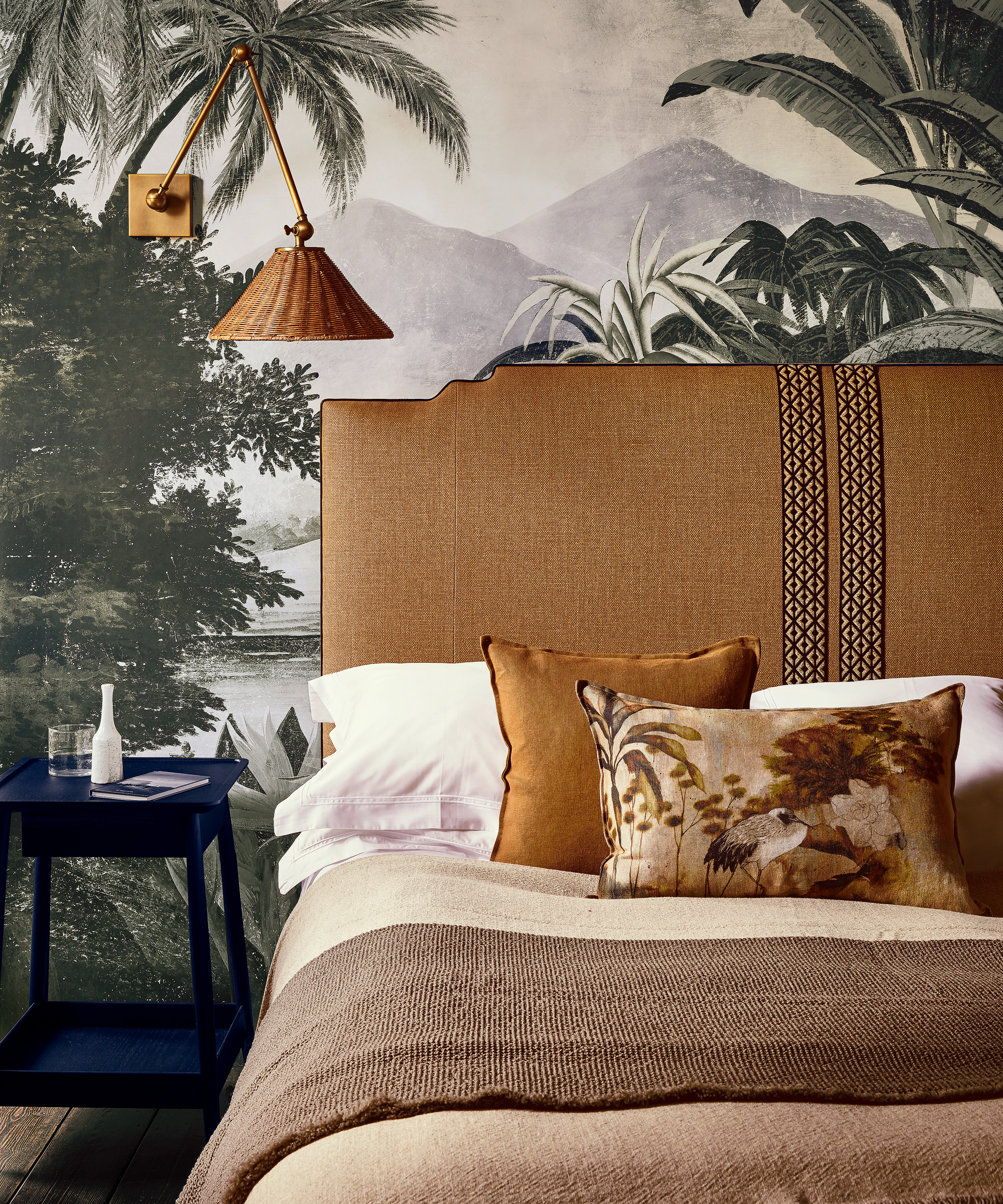
While sticking strictly to one color may sound like an easy way out of concocting color combinations, going monochromatic can make a real statement.
‘To make an impact, use one color – or tones of one color – in a room,’ says Smith. ‘If you paint walls, skirting, doors, cupboards, radiators – and even window frames – in the same color it will look thoughtful and sophisticated.’
In this example, a tonal palette is explored through the soft furnishings used in the bed ideas. Brown ochres are explored from pale incarnations on the bedspread through to robust, warm examples in the woven headboard and lampshade, through to dark details in the scatter cushions.
29. Add interest with all-over floral
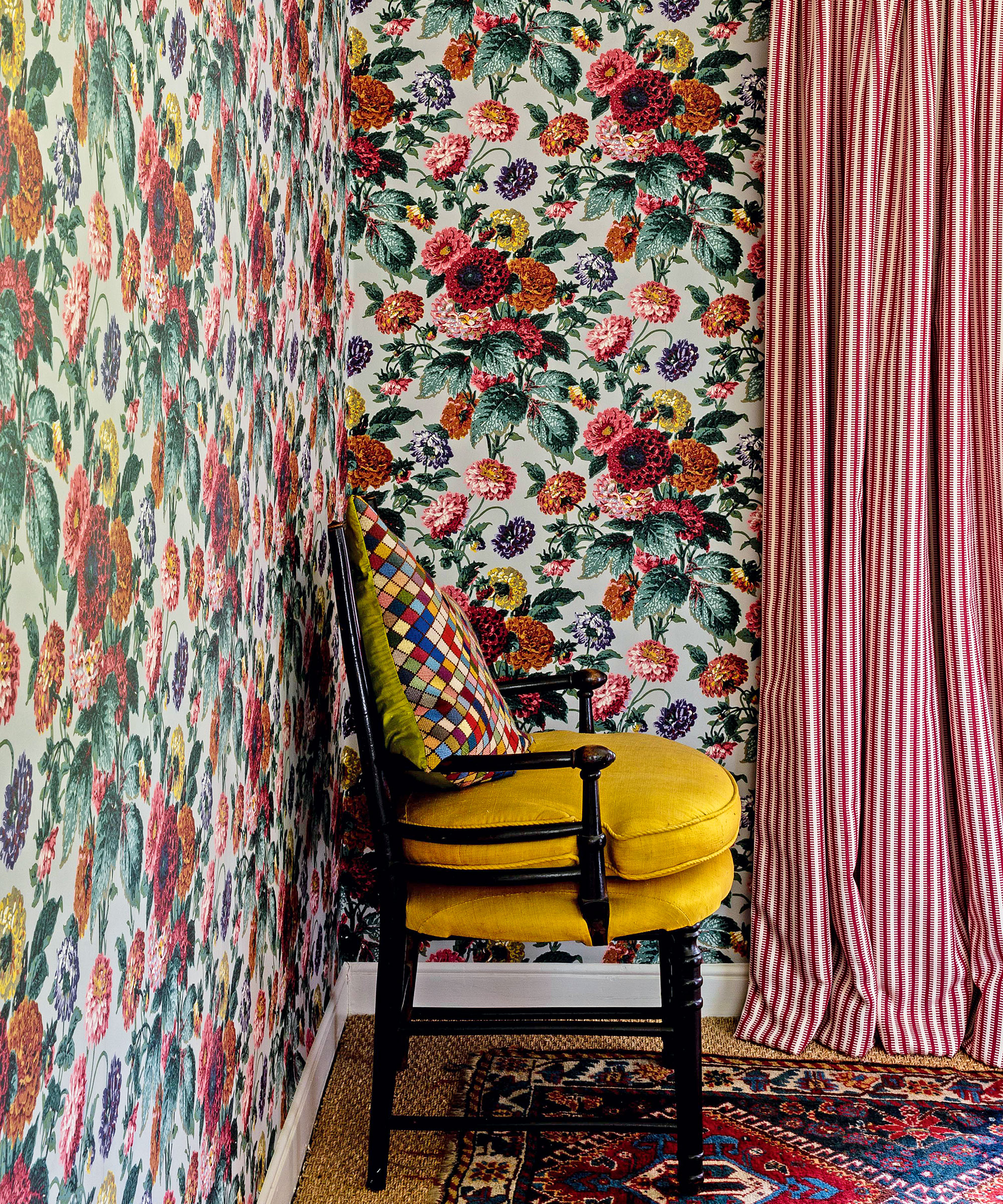
Dahlias have been enjoying a wild resurgence in popularity, so Flora Soames’ wallpaper was a bold, on-trend choice here. ‘It sets the tone for the layering of antiques and fabrics, from Soane’s Jajim Stripe curtains to an antique cushion on the chair,’ she says.
‘When choosing fabrics and soft furnishings, opt for co-ordinating rather than matching to prevent the room from looking contrived,’ says interior designer, Birdie Fortescue. ‘Try basing colors on a piece of art or favorite print – this makes a great jumping off point.’
30. Evoke stillness and serenity with color
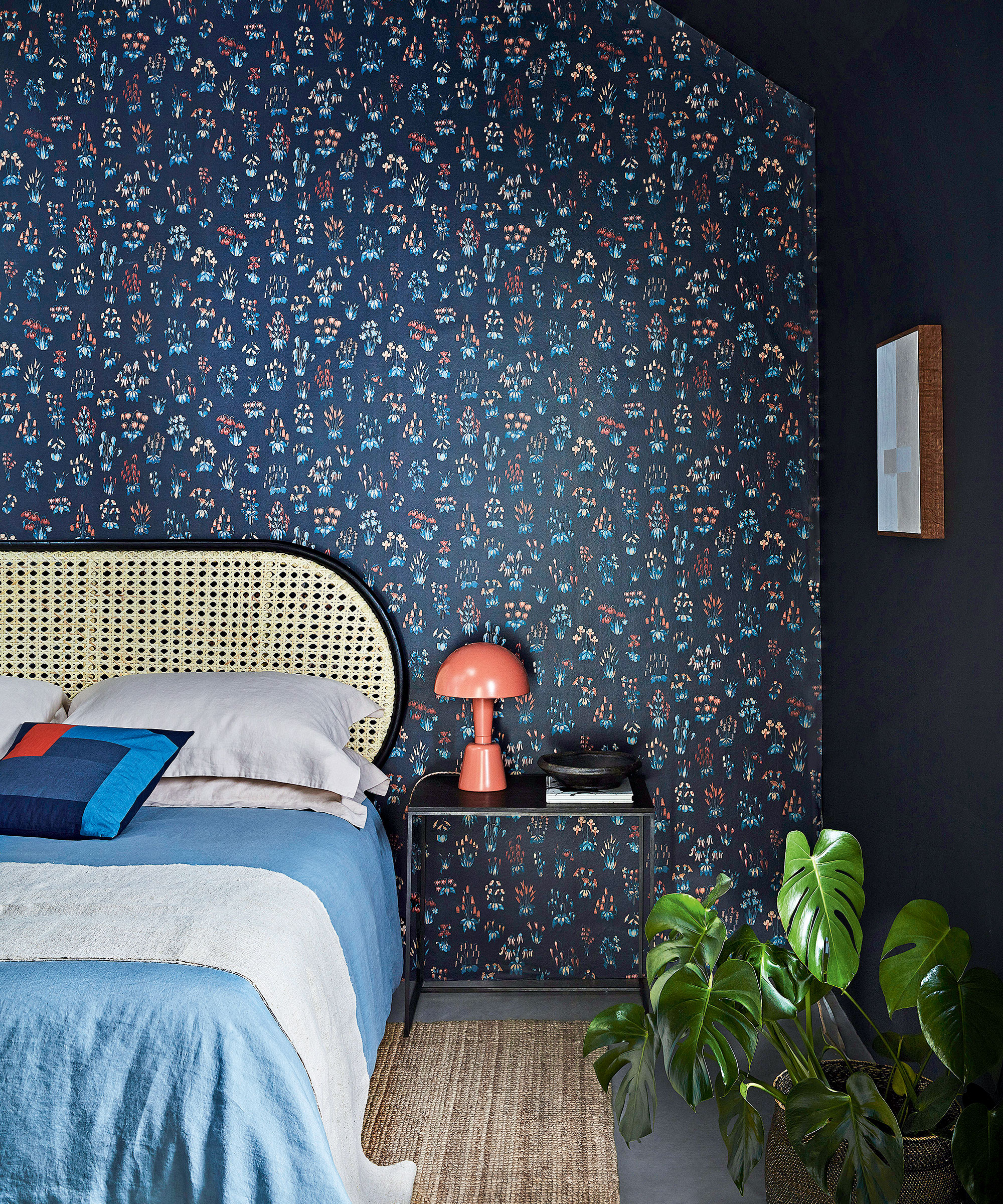
To create a soothing space, opt for deep soporific hues such as Little Greene’s Millefleur Tapestry wallpaper in Knight from National Trust Papers II Collection,’ says the company’s creative director Ruth Mottershead. ‘It works wonderfully as a feature wall behind the bed.’
31. Decorate with a soothing blue color palette
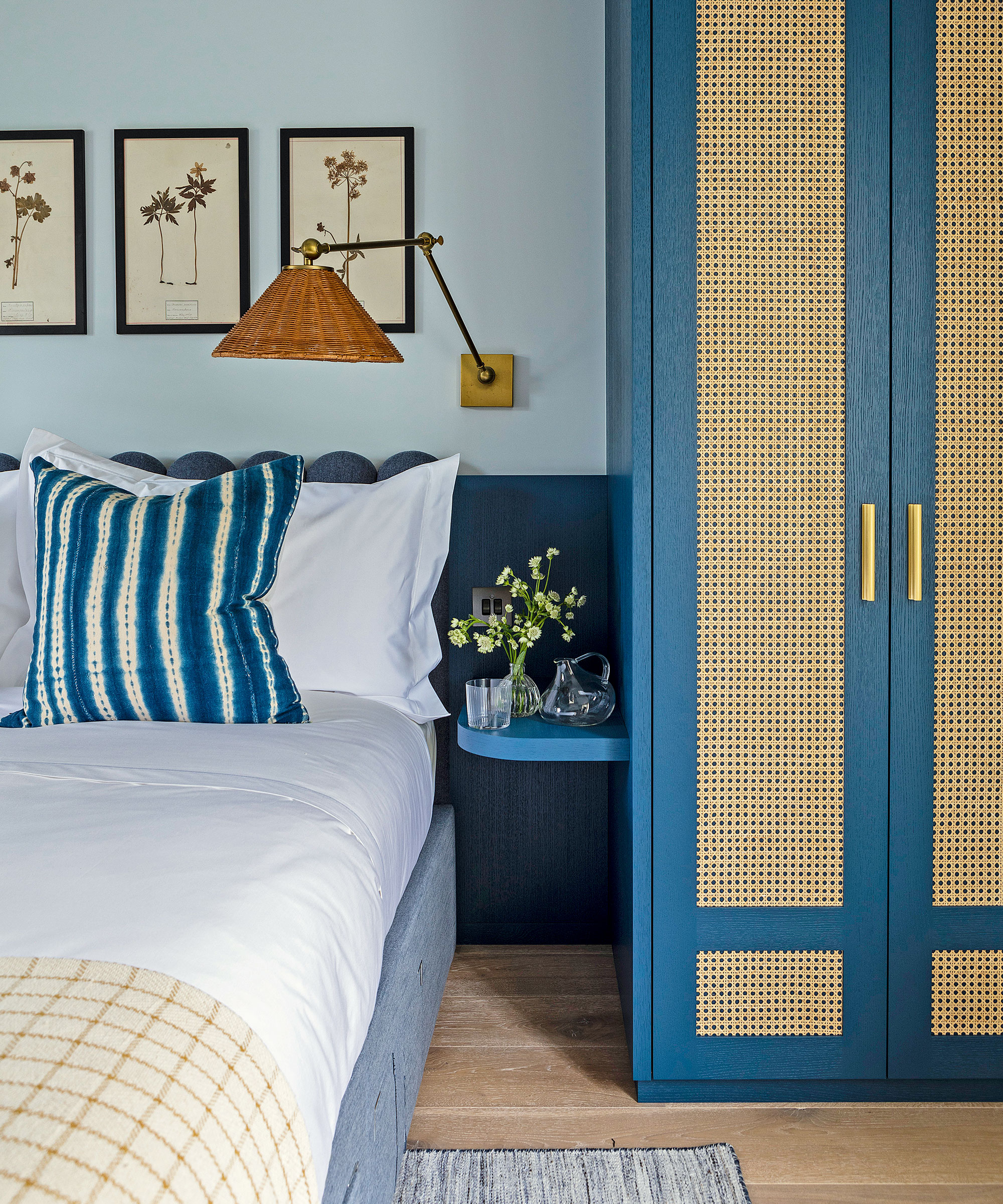
If you crave a calming atmosphere in your bedroom, blue – in all its variations – could be the solution.
Katie Lion, an interior designer with Kitesgrove, chose blues for this small but soothing space: ‘The inky teal is a beautiful color that instantly feels sophisticated and calming. We didn’t want it to take over the room so we limited its use to the headboard, cushions and built-in cupboards, then used a paler blue for the walls and ceiling (Farrow & Ball’s Skylight) which helps the room feel light and balance the darker blues' - a great option for bedroom ceiling ideas.
Katie used space-saving tricks such as wall lights (the Padma sconce with wicker shade from Arteriors), to create more surface space on bedside shelves, and discreet under-bed storage ideas.
32. Factor in harmonious hues
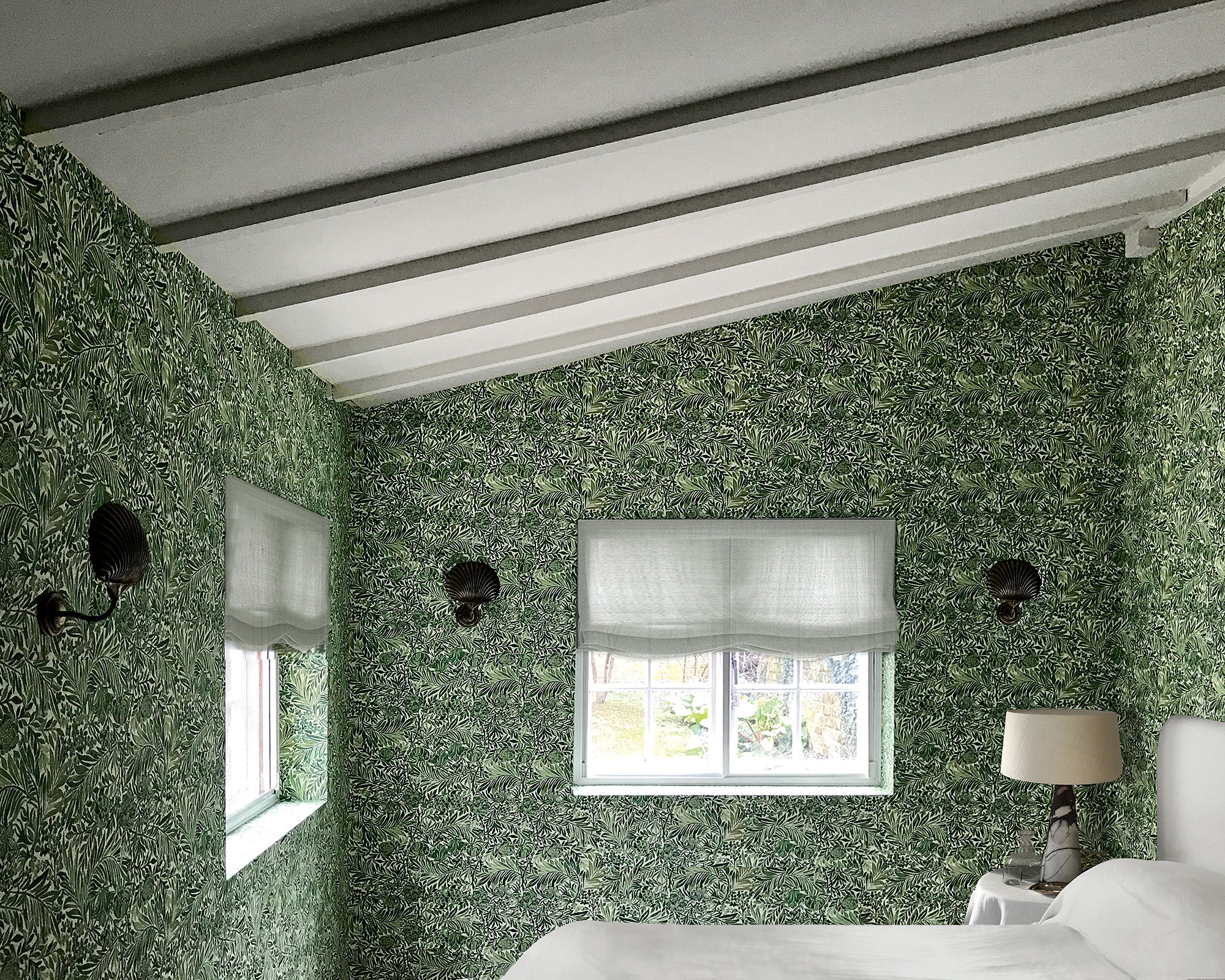
This bedroom is all about a harmonious duet in green and white. Verdant imagery and a garden room concept were central to this flat by interior designer Jessica Summer. ‘This leafy wallpaper by Liberty was the perfect note for this look,’ she says.
‘I love colorful rooms, but I like to introduce this with tonal variations and textures, rather than strongly contrasting colors,’ explains Jessica. ‘This makes a cheerful yet balanced space one will never tire of.’
33. Take a bold approach to color and pattern
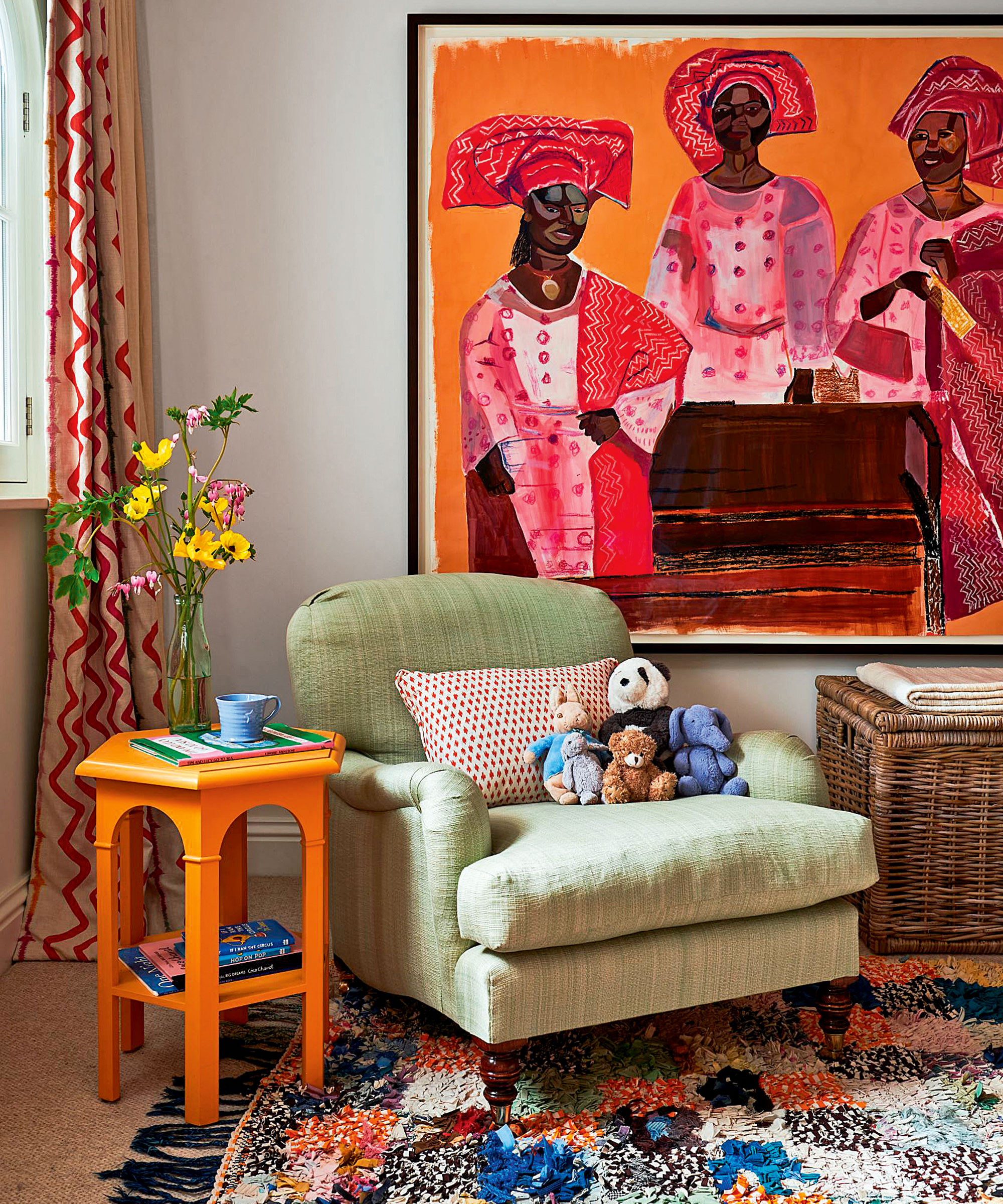
Use treasures from your travels to give your bedroom both artistic interest and personal meaning. ‘We designed this vibrant girl’s bedroom to complement the client’s art collection,’ says interior designer Kate Guinness who sourced the rug in Morocco.
34. Work in threes
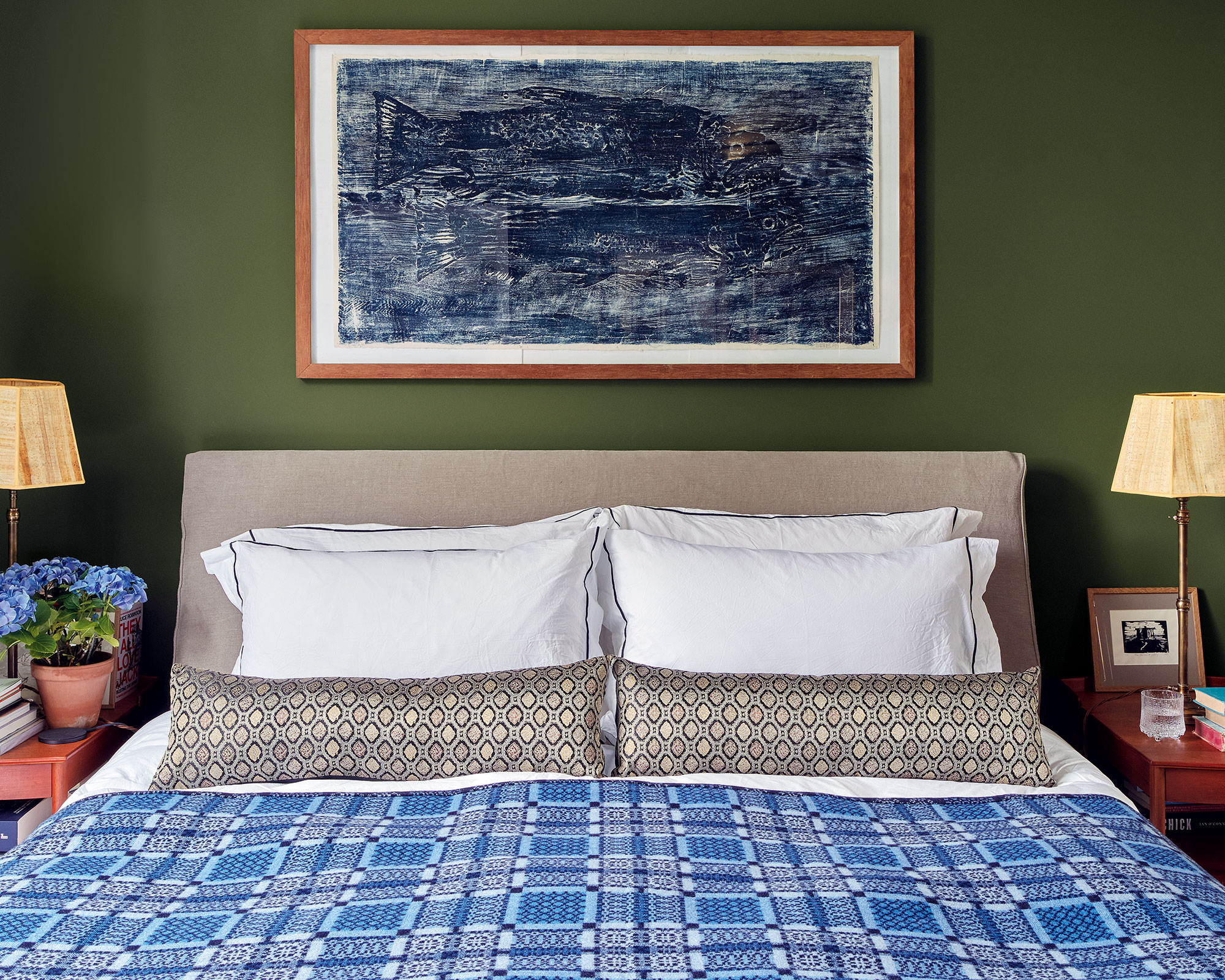
A simplified palette can be a good way to approach a bedroom, especially when you are daunted by the sheer variety of color options.
‘Any more than three colors in a bedroom can be overpowering,’ says interior designer Tom Morris. ‘This space is large so we went for this deep green (Little Greene’s Olive Color), which is a backdrop to the indigo colors in the fabrics and the print above the bed.
What is the most relaxing color for a bedroom?
The most relaxing color for a bedroom is down to personal preference, but blue has been proven to induce a calming effect on the brain and is therefore an enduring favorite in the bedroom. Pair with crisp whites for a fresh look, or layer muted tones for a softer scheme. It even works surprisingly well en masse in darker shades – wall-to-wall navy blue is a growing favorite that looks stylish and is super relaxing.
Outside of blue, consider its closest relatives. After a year or so of being stuck indoors, green is gaining popularity for its affiliation with nature. Choose shades of sage and olive to stay on-trend, or create a jewel box effect with emerald. Purple works well for a warmer scheme, while soft greys are an on-trend choice for a soothing, neutral scheme.
And relaxing hues don't end with your paint or decor choices. Instead, experts have shared the best bed sheet colors to improve sleep, so you can rest easy that every detail in your room is working well for your wellbeing.

Jennifer is the Digital Editor at Homes & Gardens, bringing years of interiors experience across the US and UK. She has worked with leading publications, blending expertise in PR, marketing, social media, commercial strategy, and e-commerce. Jennifer has covered every corner of the home – curating projects from top interior designers, sourcing celebrity properties, reviewing appliances, and delivering timely news. Now, she channels her digital skills into shaping the world’s leading interiors website.
- Ailis BrennanContributing Editor
- Pippa BlenkinsopContributor